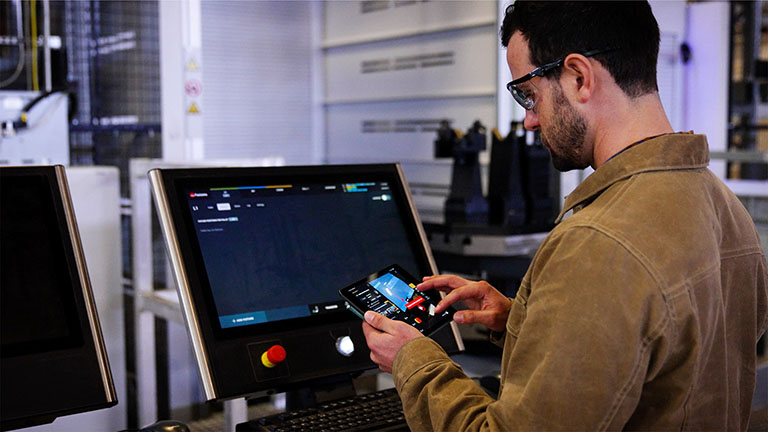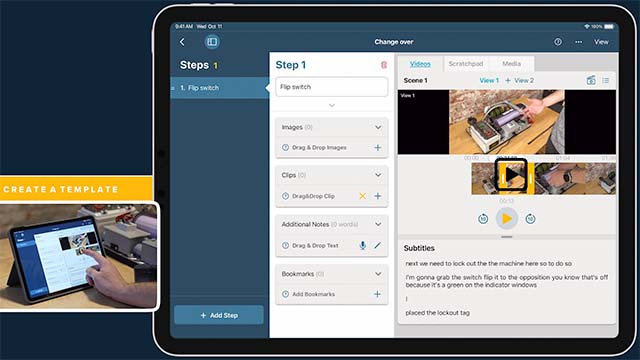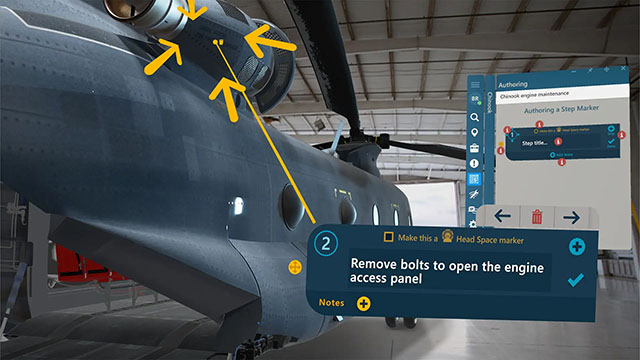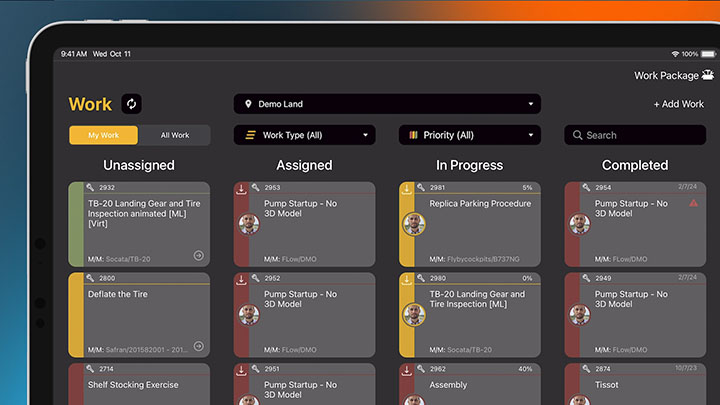Create New Work
From the Manifest 3D Application:
Jobs
- Search for or scan the Asset Tag associated with the desired Asset to navigate to the Asset Detail window
- From the Asset Detail window, select Templates
- Find the Job Template in the Template list and select to open into a new window
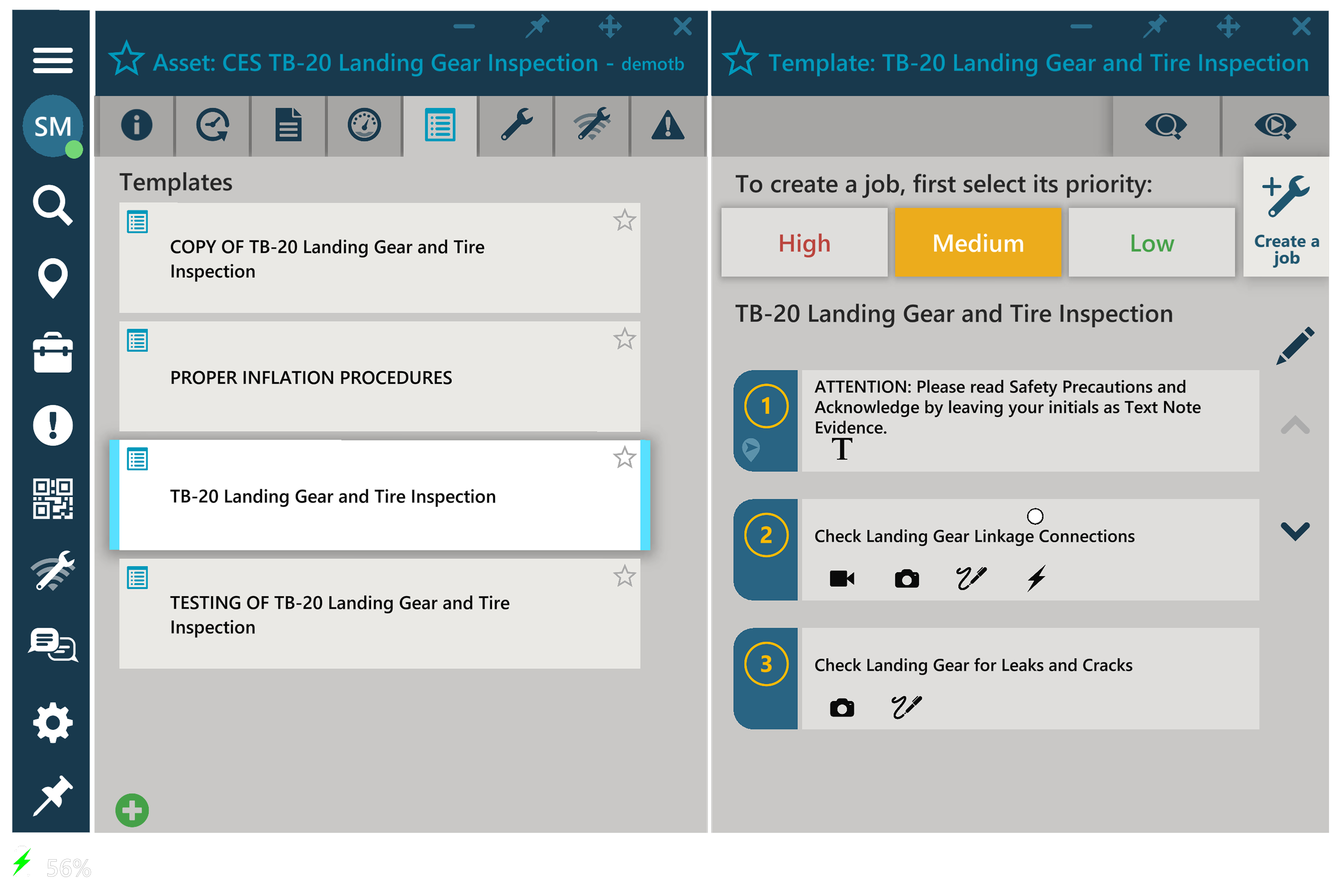
- In the upper right-hand corner of the Template window, select the priority (this enables Create Job), and then select Create Job
- The Job will open in a new window
- Select Start to begin the Job
Tasks
Tasks in the Manifest 3D Application can only be created from a Fault.
- From the Asset Detail window, select the Faults tab
- Navigate to the desired Fault and select to expand the detailed view
- To view the Fault in AR, select the eye icon to show the Fault Marker
- From either the Fault Listing or the Fault Marker, select Add Task
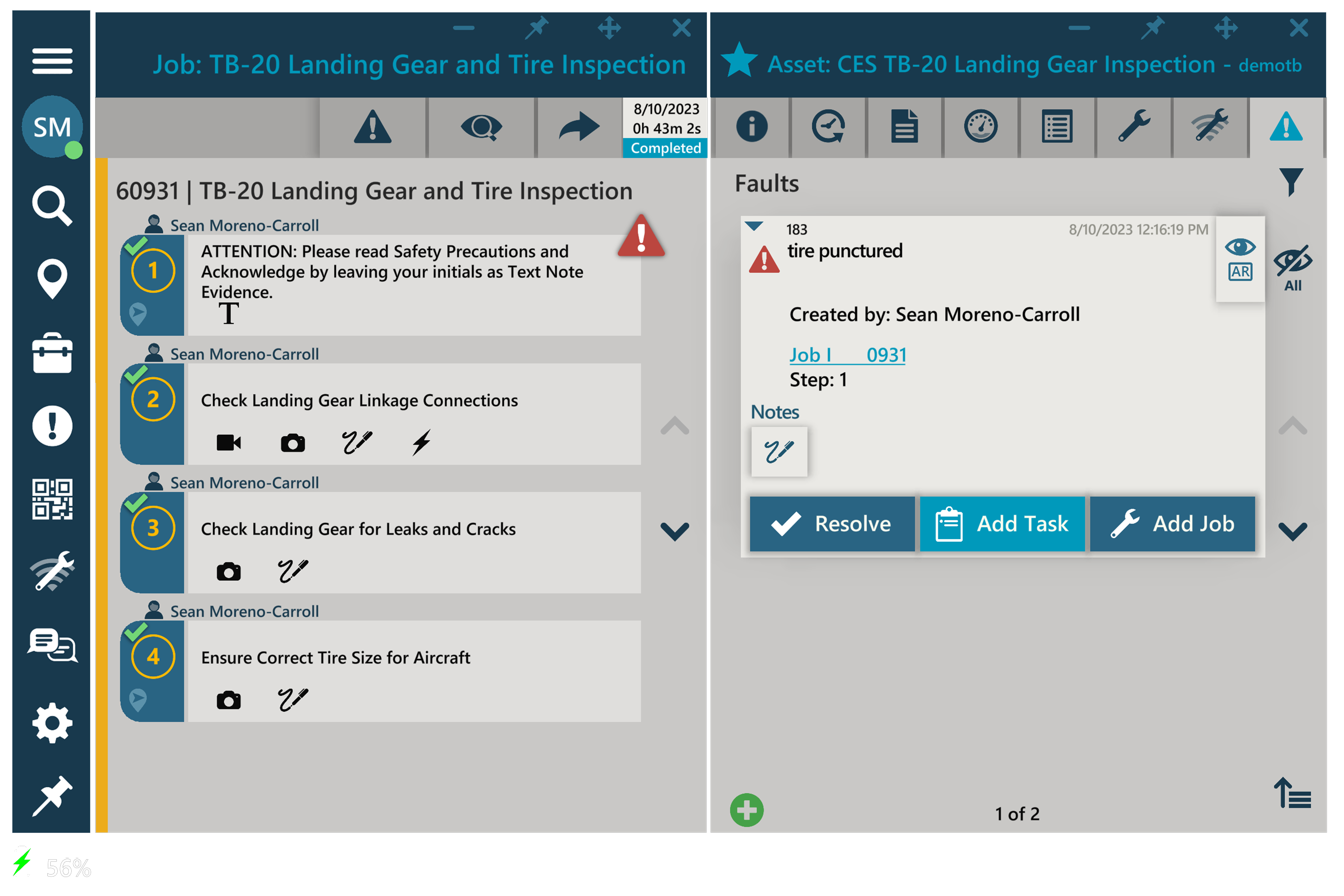
- Input the Task Description
- Select the Fault Priority (Medium is selected by default)
- Select the green checkmark to create the Task
Find Work
Below are various paths and instructions to navigate to the desired Work, depending on the focus. Work listings are differentiated by an icon in the upper left-hand corner of each listing.
From the Dashboard – My Work tab
Users can find Work assigned to them via the Dashboard’s My Work tab.
- Select the User Profile icon located at the top of the Dock to load the Dashboard (a personalized view of Work, Favorites, and Recent Activity)
- Select the tab My Work (the My Work tab will load all ‘Assigned’ or ‘In Progress’ Jobs and Tasks assigned to the current user)
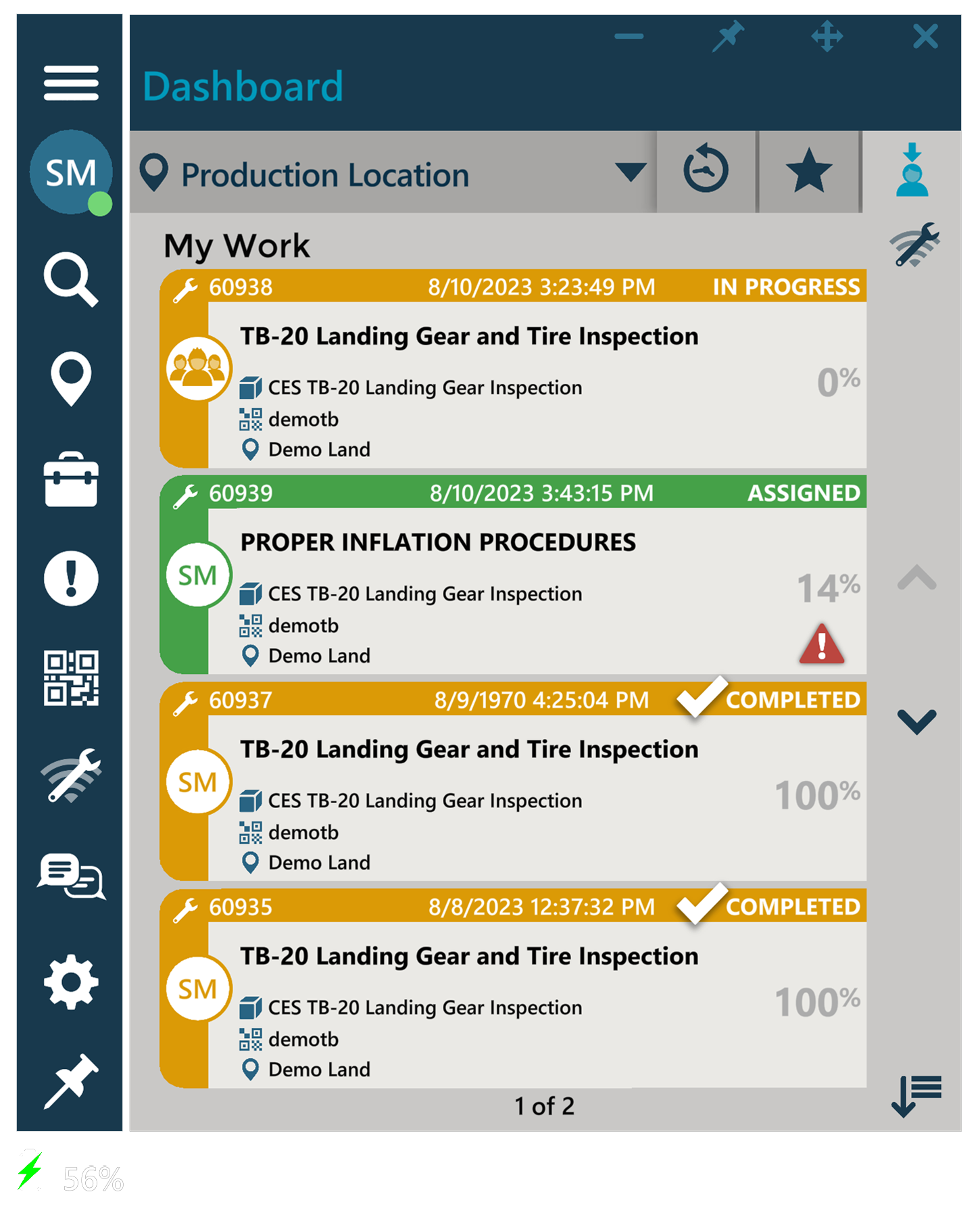
- Use the Sort or Filter options to further refine the results as needed
- Find the desired Job or Task and select to open into a new window
From the Asset Detail window
When focusing on a specific Asset, users may find all Work for that Asset under the Asset Details Work tab.
- Search for the Asset or scan the Asset Tag for the desired Asset and go to the Asset Detail window
- From the Asset Detail window, select Work
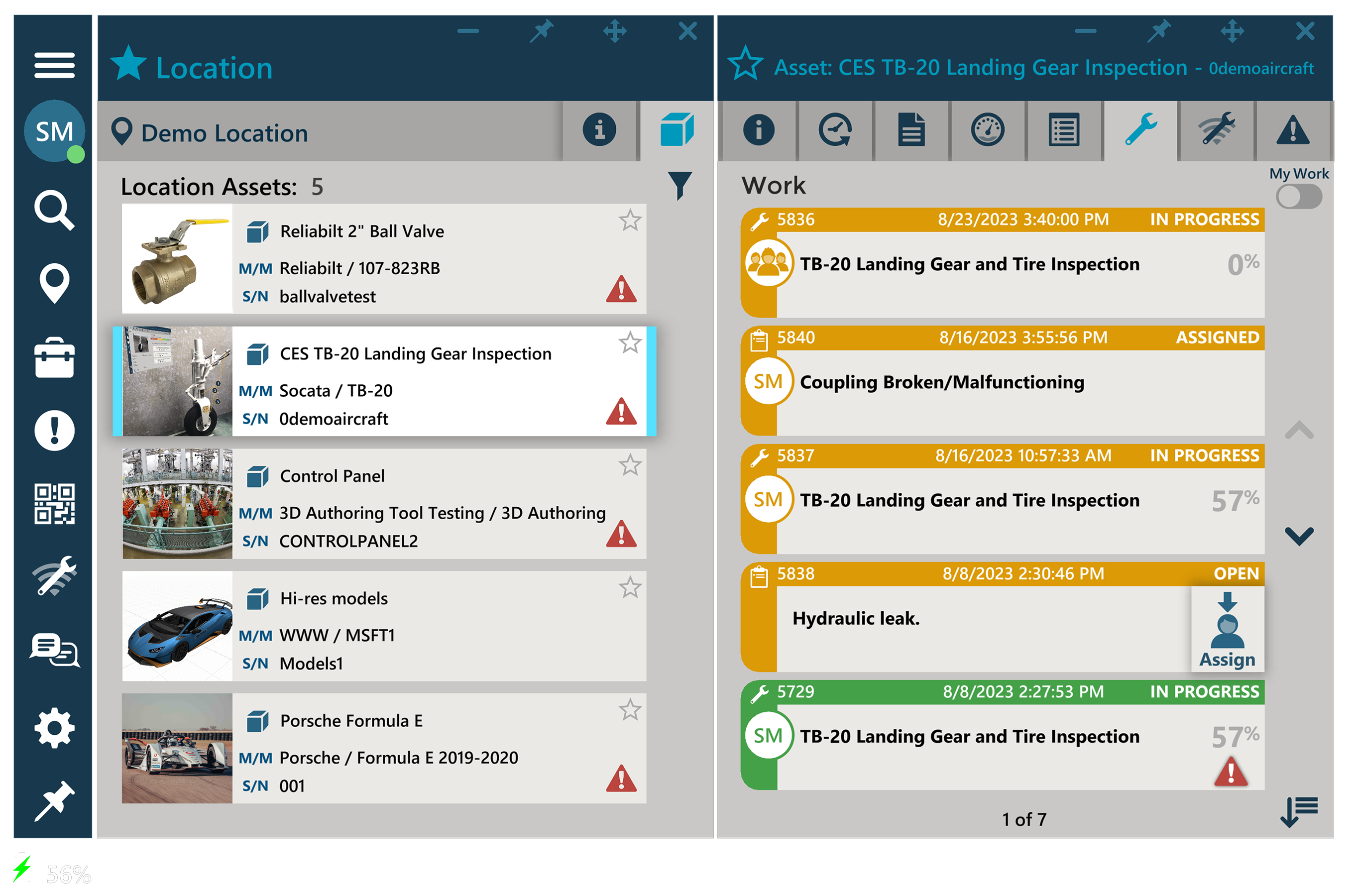
- Use the toggle button in the upper right-hand corner to filter by ‘My Work’
- Find the desired Job or Task in the list and select to open into a new window
From the Work window
To view all Work across an organization’s domain, regardless of Location, Asset, or Assigned user – use the Work window. From within the Work window, users may filter by Location, Work Type, Status, or Priority.
- Open the Work window by selecting Work on the menu
- Use the toggle button in the upper right-hand corner to filter by ‘My Work’
- Find the desired Job or Task in the list and select to open it in a new window
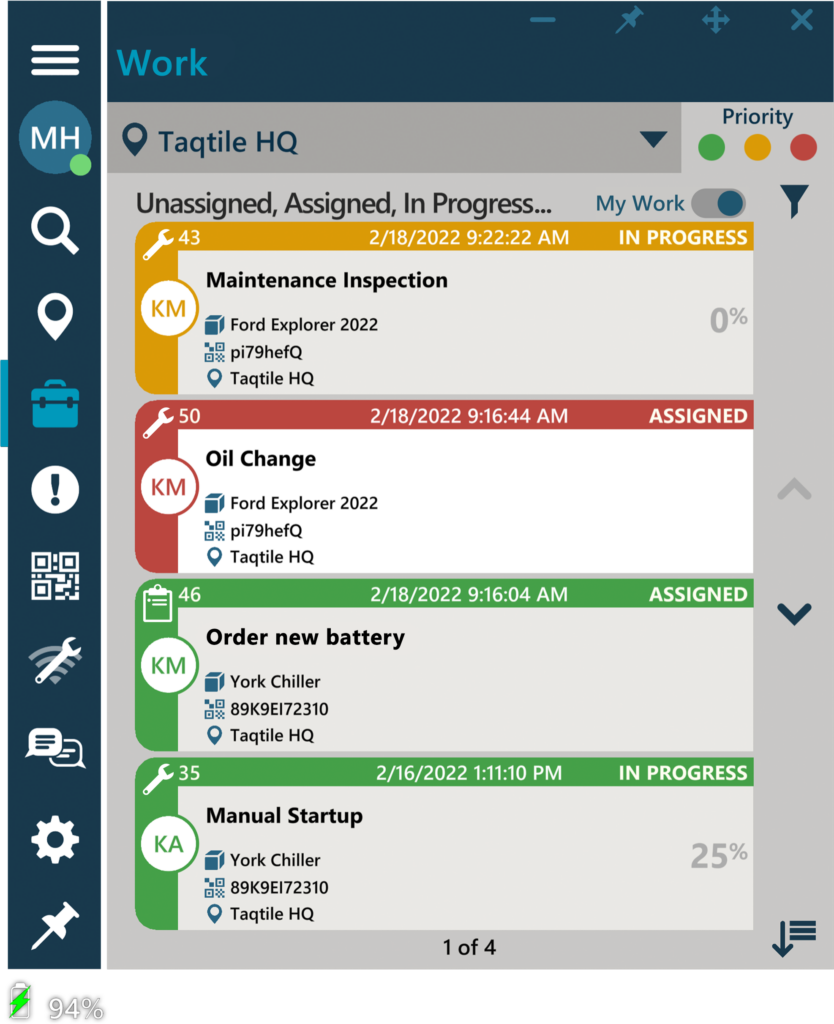
Assign Work
Self-Assign a Job or Task
- From the Dock, select the Work icon to open the Work window
- To filter by Unassigned, select the Filter icon and check the option for Unassigned
- Unassigned Job and Tasks will display a large Assign button on the right side of the Work Listing
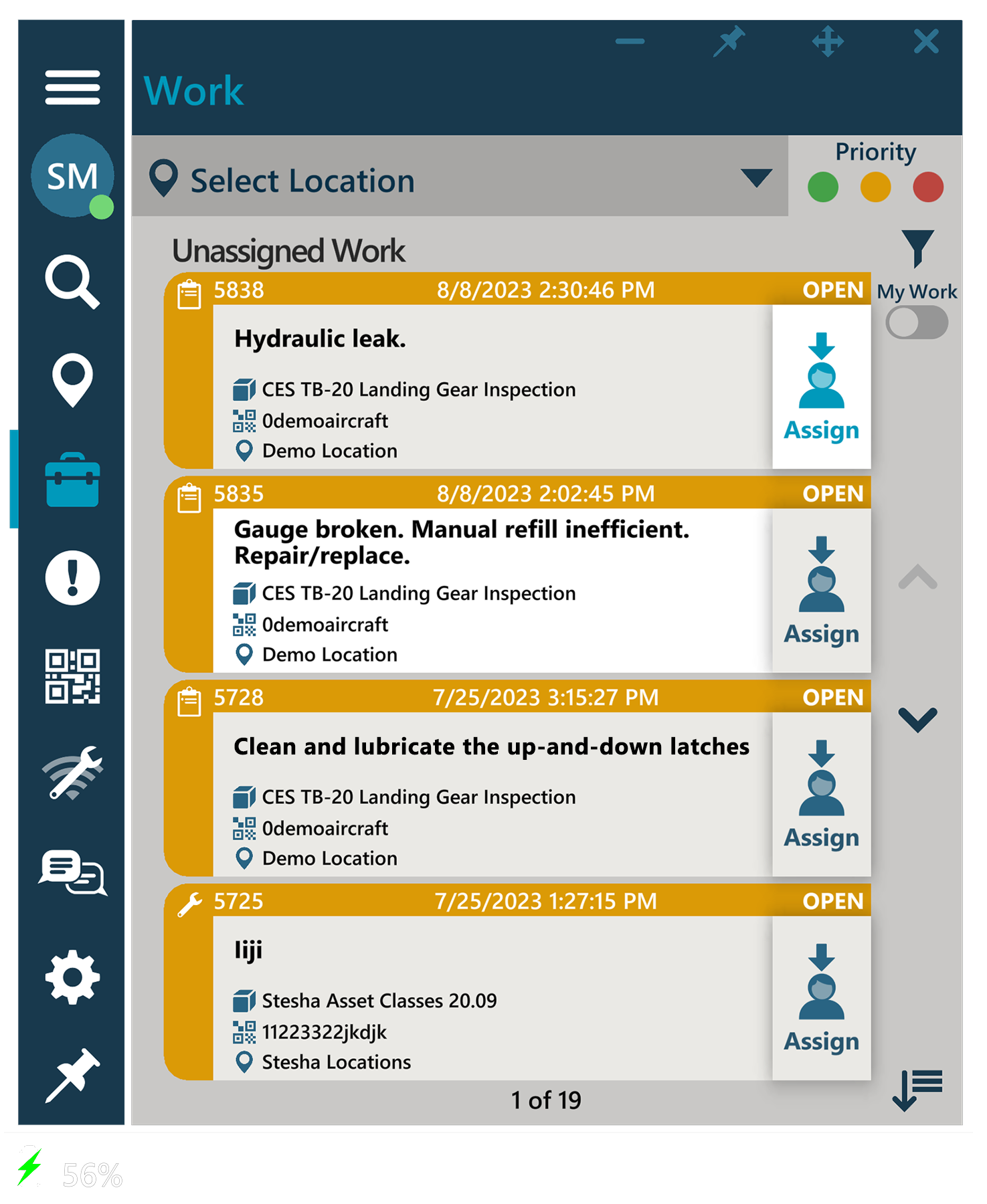
- Select Assign
- *Note: When a Job is created in the Manifest 3D Application, it will be automatically assigned to the Operator who created it. To reassign a Job, see the Reassign Work section below.
Assign a Task
- Select the Task to open the Task Detail
- Select the Assign Task button in the top header menu
- A list of Contacts will open to the right
- Select the desired Contact
- Select Assign from the bottom bar
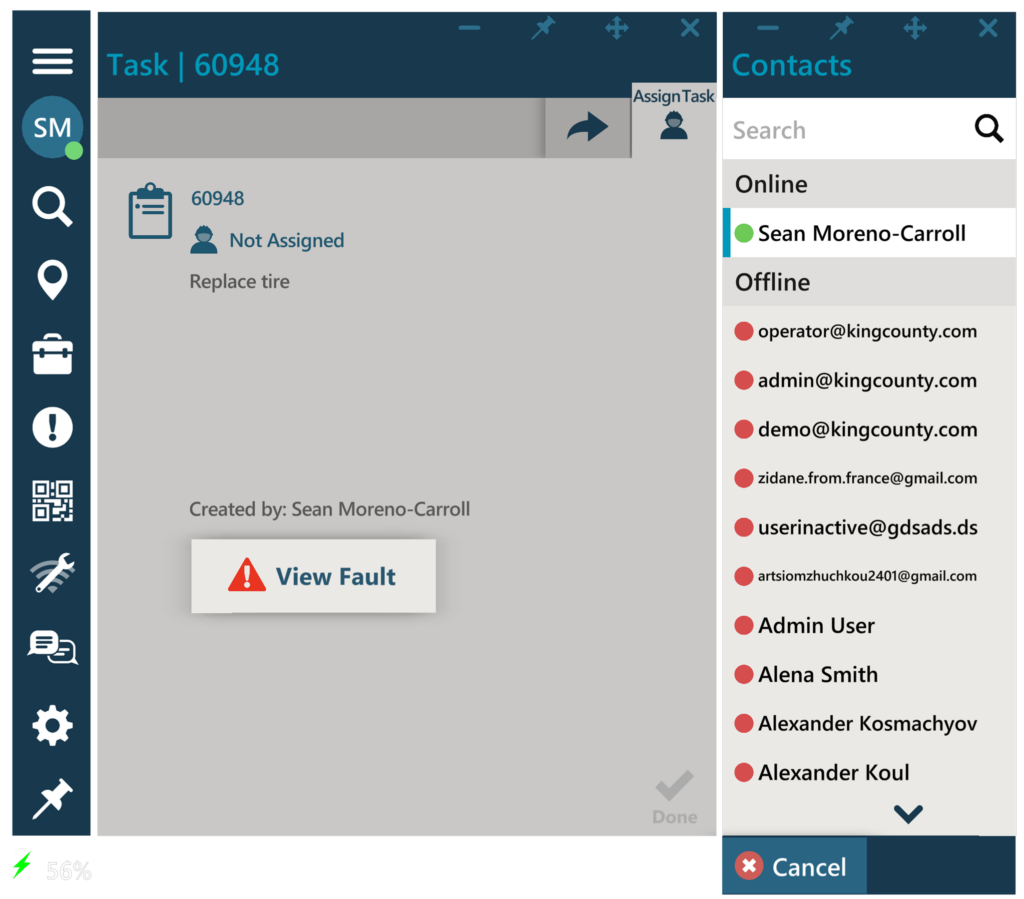
Reassign Work
The assigned user for any Work item may reassign that Job or Task to another Operator at any time prior to Work completion. Reassigning Work will assign all remaining incomplete Job Steps and/or the Task selected to the new Operator. This option can be used for on-the-fly handoffs, shift-work transfers, or to recruit help from another Operator.
From an Active Job
- While a Job is in progress, select Assign from the Job Step Marker
- A list of all licensed Manifest Operators for the domain (and their online status) will slide out to the right of the Step Marker
- Select the desired contact and then select Assign
- Note: To Unassign the Job, select Unassigned (the first listing in the Contact list)
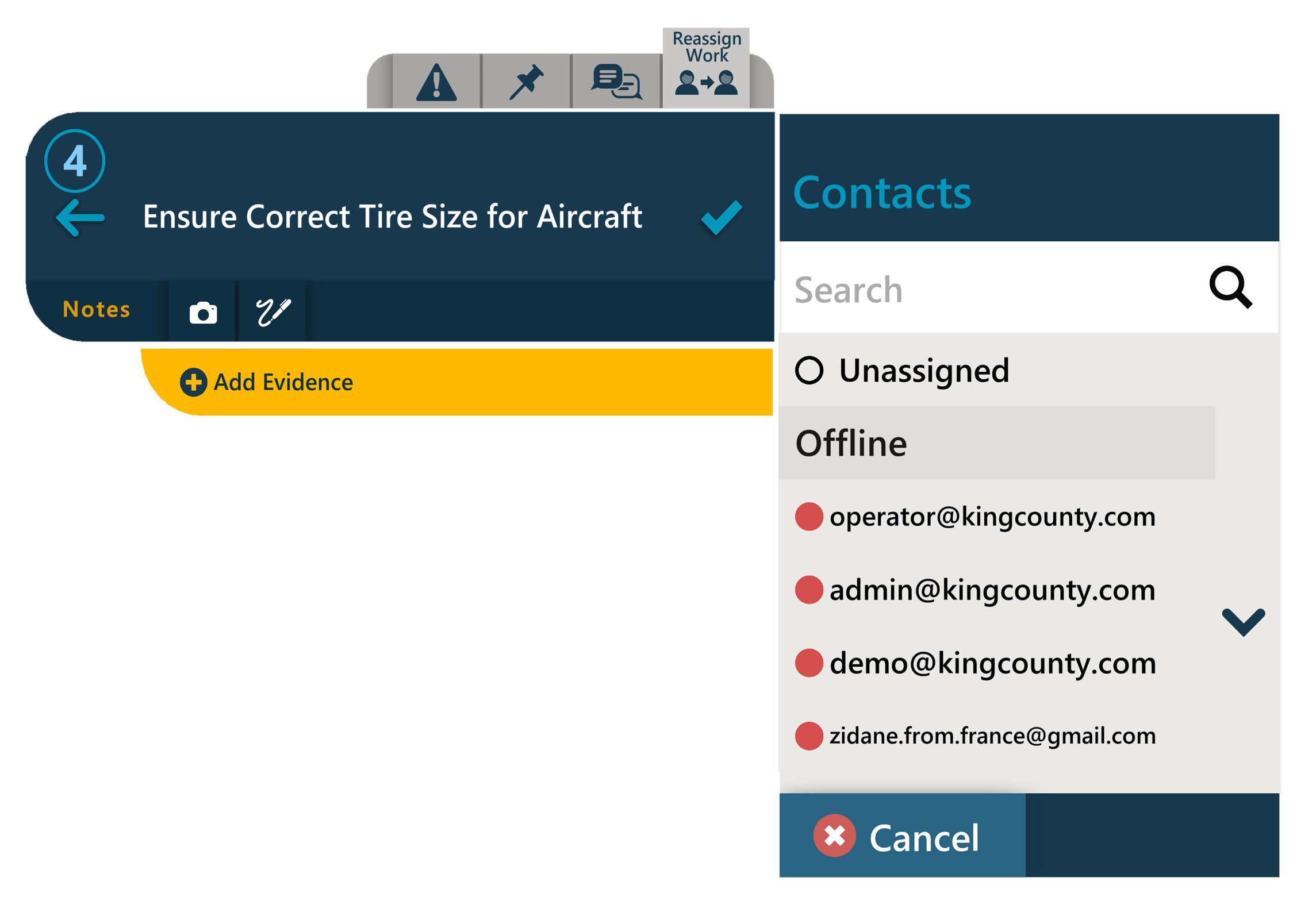
- Note: To Unassign the Job, select Unassigned (the first listing in the Contact list)
- The Step Marker will update to show a ‘Pending’ status until the Job assignment is accepted or the invite is canceled
- The assigned Operator will receive an invitation alert via Manifest Connect with the options to either Accept or Decline
- Upon acceptance, the assigning Operator will receive an acceptance message and the Start/Resume Job option will disappear. It’s important to note that once the Operator accepts the Job assignment, they will now own that Step and all subsequent Steps until the Job is completed or reassigned
- To cancel a Job assignment, go to the Connect Chat and select Cancel on the Job assignment invite card (this may not be done once the invite has been accepted)
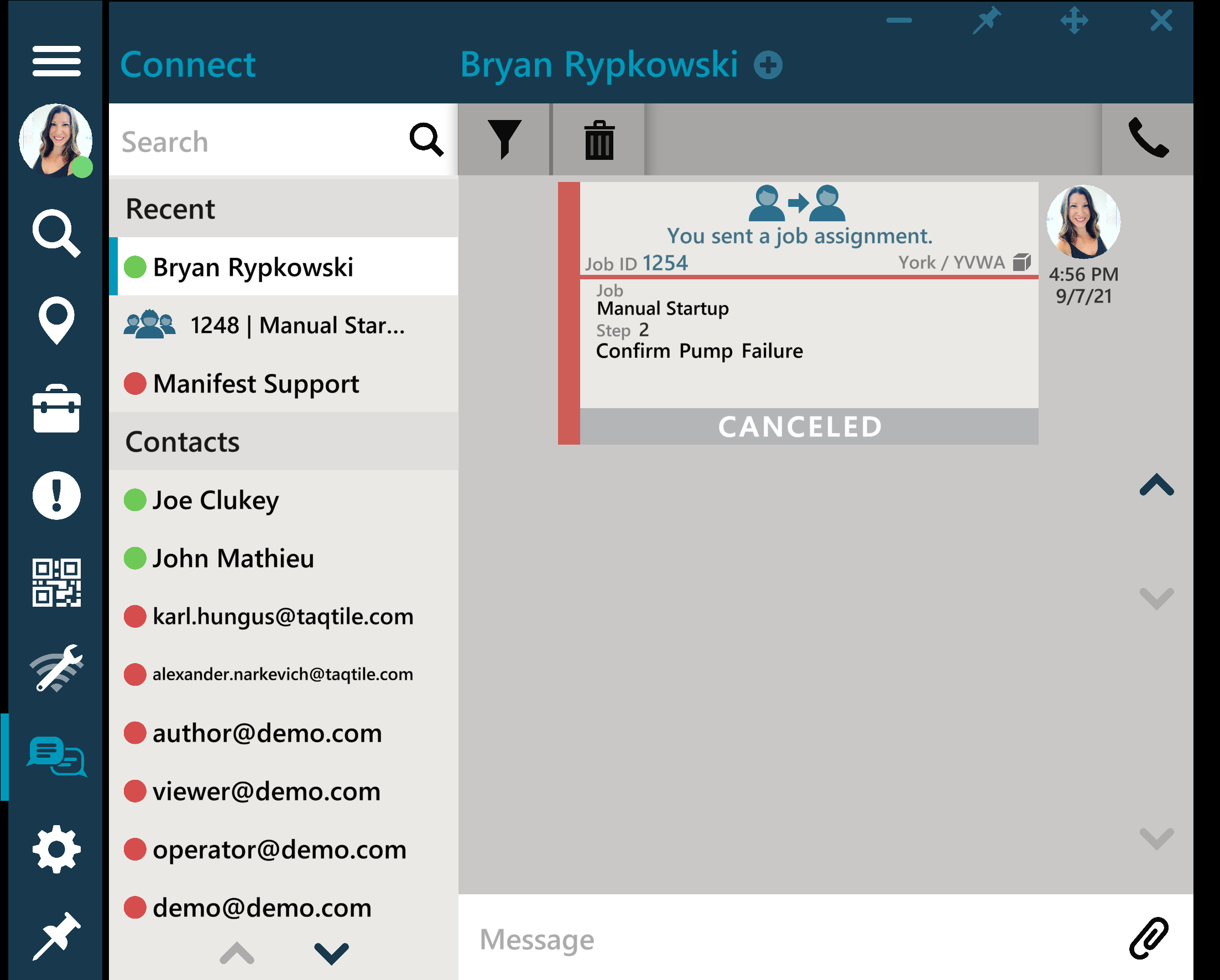
- The new Operator may reassign the Job back to the original Operator or another Operator as needed
Accept an assignment invite
- If a Step is assigned to an Operator, a Job assignment invite will be sent to the assigned Operator via a Manifest Connect Chat (the Job card includes important details about the Job and Step number with the options to Accept or Decline)
- To accept the Job assignment, select Accept
- Once the Job assignment is accepted, the window will automatically update and drop the newly assigned Operator into the Job checklist
- If the Job assignment is declined, the Job Step will be returned to the originating Operator
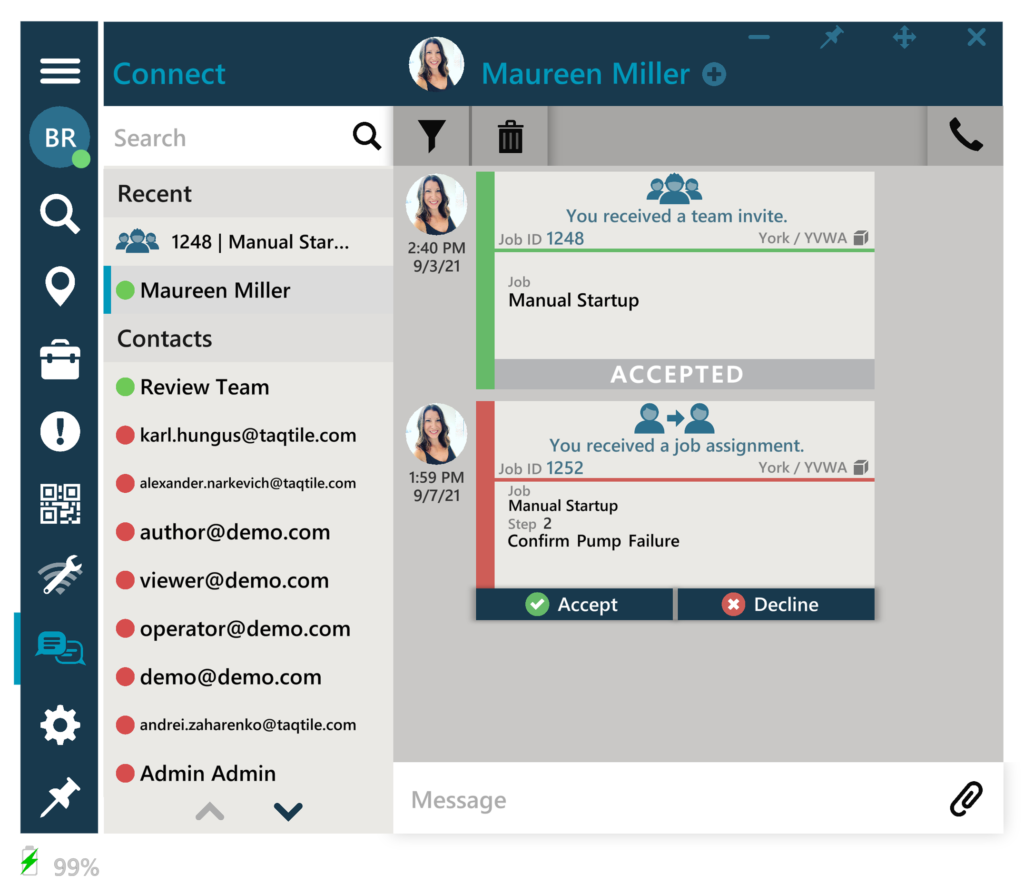
Complete a Task
- Locate the desired Task
- Select to open the Task Detail window
- Once complete, select Done
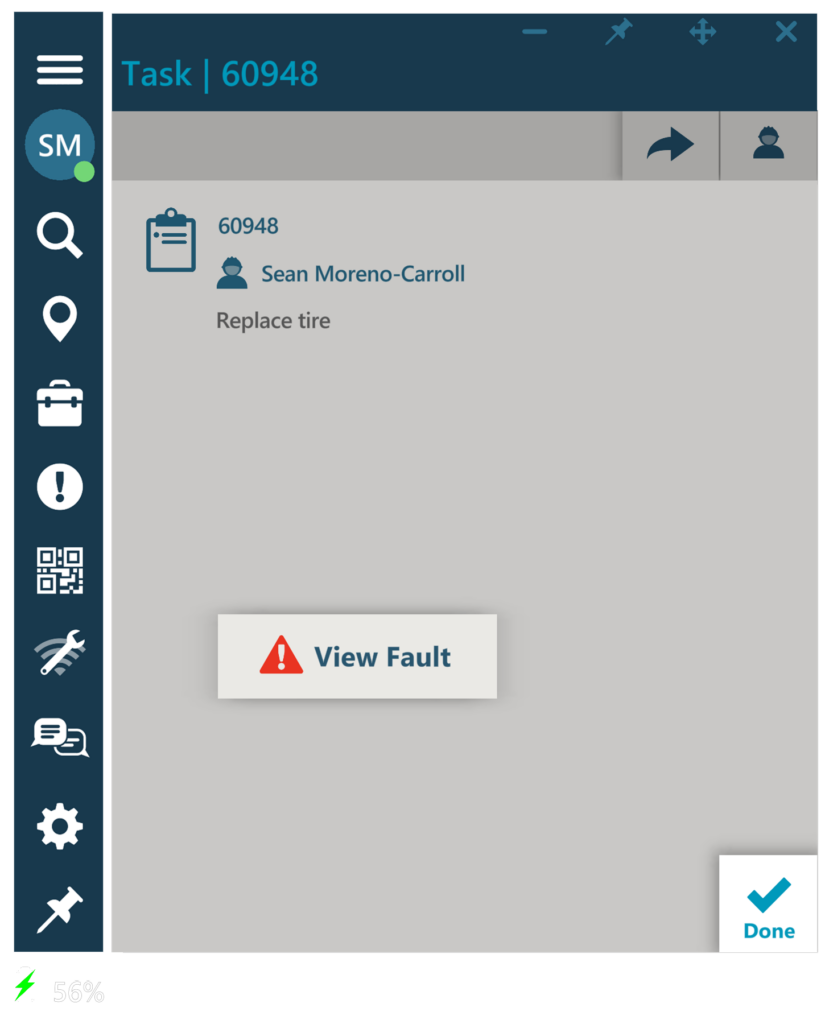
Share a Task
- Locate the desired Task
- Select to open the Task Detail window
- Select the Share button in the top window bar to open a list of Contacts
- Select the desired contact
- Select Share
- The Task listing will be shared with the contact via Connect Chat
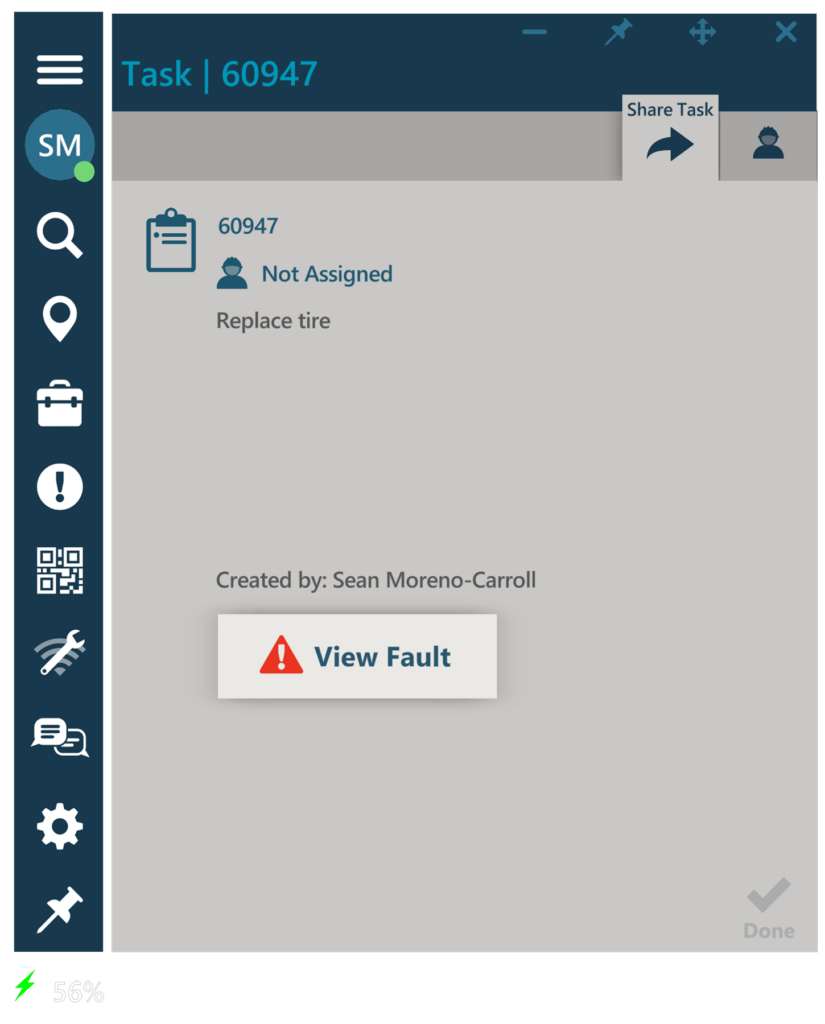
Perform a Job
To perform a Job using the Manifest 3D application, it is first necessary to find and select the Job from the Work tab. Once Selected, simply follow the directions below.
From Job Checklist
- To perform a Job using the Manifest 3D Application, select the desired Job from the Work window to open the Job window
- In the upper left-hand corner of the Job window, select Start Job to start or resume the Job
- Note: This selection will only be available if you are assigned to the Job and own the next available Step
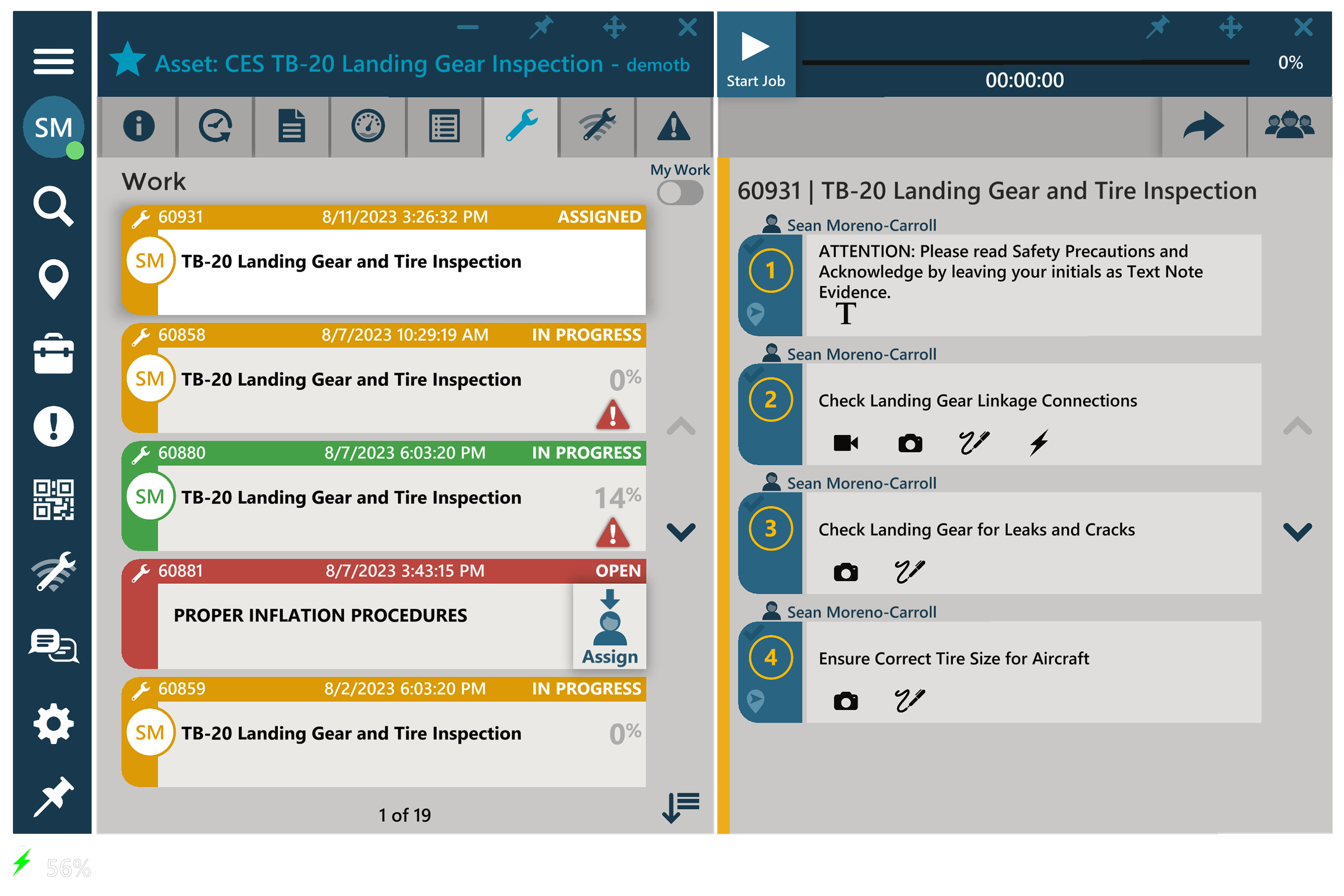
- Note: This selection will only be available if you are assigned to the Job and own the next available Step
- If the Asset Tag has not already been scanned or manually placed, the Operator will be prompted scan or place the Asset Tag
- Locate the 3D Step Marker for the Step (If the Step Marker is out of the field of view, an arrow will point to its location. Headspace Step Markers will render directly in front of the Operator and then follow their gaze)
- Review the Step instructions displayed on the Step Marker and any Step Notes the Author may have associated with each Step
- Perform the task and when complete, select Done on the Step Marker. This will automatically advance the instructions to the next step
- Note: All Steps must be completed in sequential order. Steps cannot be skipped
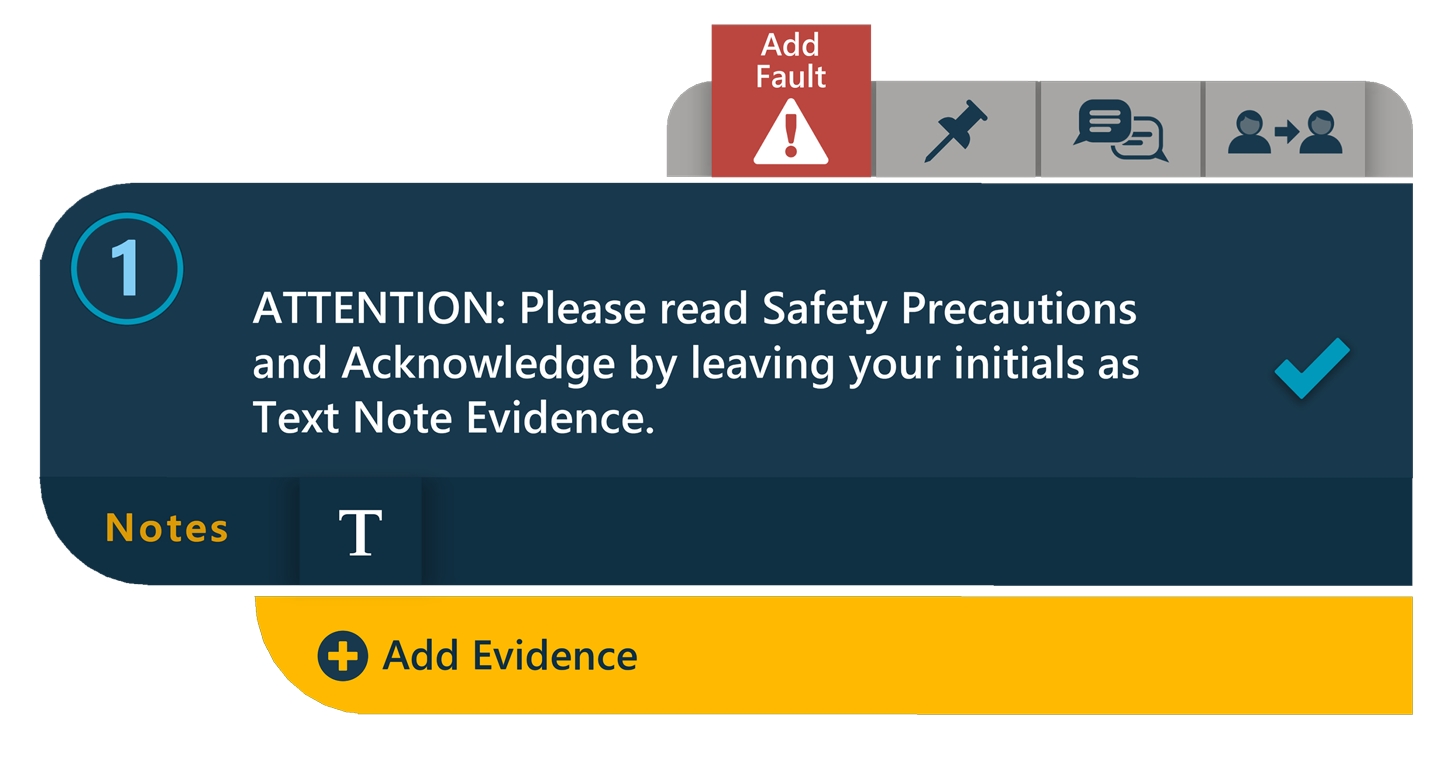
- Note: All Steps must be completed in sequential order. Steps cannot be skipped
- Once the last Step is completed, the Job window will refresh to display the final logged Job time and completion date
- The Job may now be located under the Job History tab in the Asset Detail window
Performing a Job – quick tips
Below are some quick tips and notes for Operators performing Jobs using the Manifest 3D Application. Additional sections of this post will dive into more detail for the relevant features.
| Step Notes | If there are Step Notes associated with a Step, icons will be indicated in the 3D Step Marker or underneath the Step, in the Job checklist window (select each Note type to open and review) |
| Auto-Play Notes | If an Author has set the Note to ‘Auto-play’, the Note will automatically slide out and play during the Job |
| Head Space Step Markers | Head Space Markers are Job Steps that are not spatially anchored and will use a ‘tag-along’ UI to follow the Operator as they work (to keep a Head Space Step Marker in a fixed position, select the pin icon) |
| Adjusting Step Marker positions | The position of a Step Marker can be adjusted by selecting the area with the Step number, and then holding and dragging to the desired location |
| Go Back | Operators may go back to any previous Job Step by selecting the back arrow to review again or add Evidence Notes, but steps cannot be skipped |
| Job completion stats | The elapsed time can be seen in the header of the Job checklist window along with the percentage complete and a progress mete |
| Pause Job | To pause a Job, select Pause Job |
| Exit a Job | Closing the Job checklist window will automatically pause the Job before exiting |
Adding Job Evidence
Operators may optionally (or sometimes as a requirement) leave evidence with a Job Step indicating what was done. To leave Evidence Notes on a Step, follow these steps:
- From the Step Marker, select the yellow bar titled Leave Evidence
- A dropdown list of Evidence Note types will be displayed (any required Evidence will be denoted)
- Select the desired Note type and follow the instructions
- Once an Evidence Note has been added, a number in a yellow circle will appear next to the note type to indicate how many of each note types have been left at this step
- *Note: When leaving Meter Evidence, a manual recording of a meter reading or measurement can be logged. If there is an issue with the current meter reading, a box can be checked flagging a Fault. The Flag and its associated meter reading will be added to the Meter Evidence Report in the Manifest 3D Application
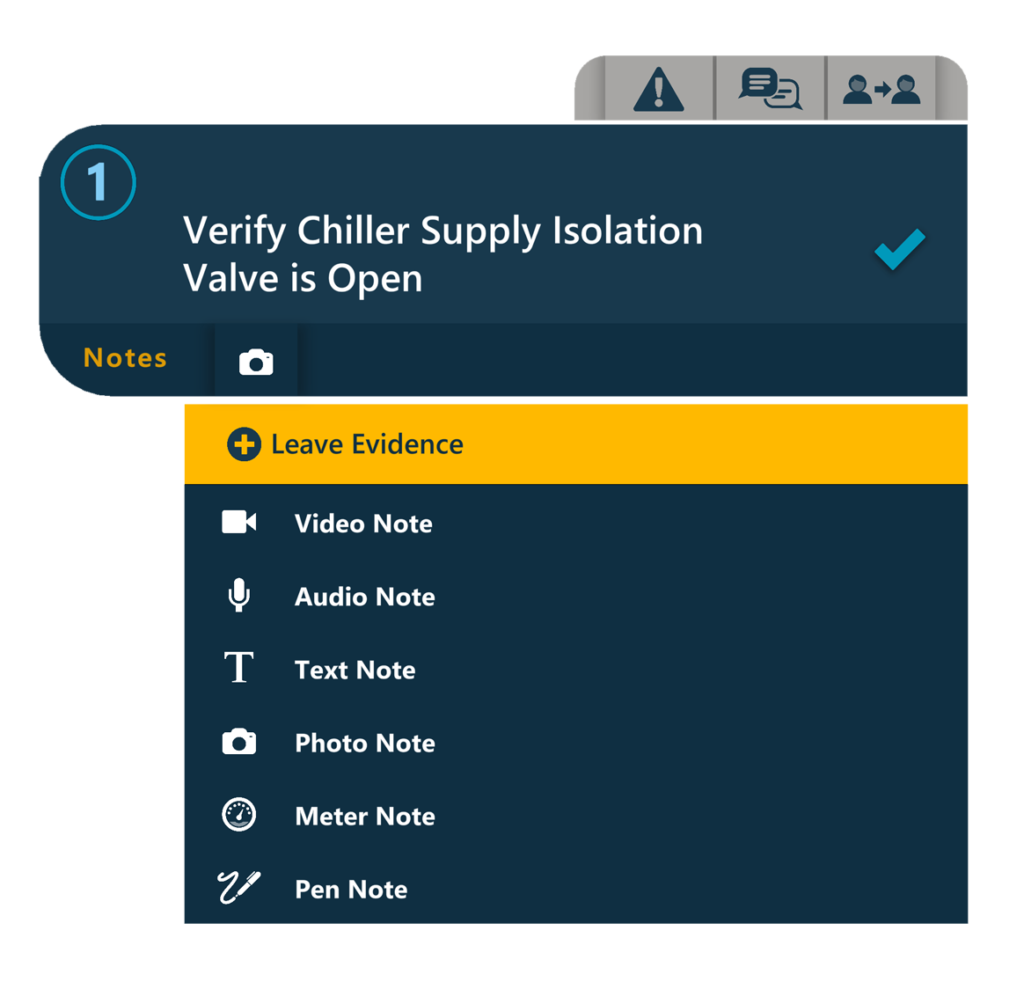
Job restrictions or requirements
Operators may optionally (or sometimes as a requirement) leave evidence with a Job Step indicating what was done. To leave Evidence Notes on a Step, follow these steps:
Required Evidence
If a Job Step is set to require Evidence Notes, this will be denoted on the Job Step and next to the respective Note type in the Evidence list. The Step may be set to require a specific Evidence Note type (photo, video, pen, etc.) or accept any note type to show evidence of the Work performed. The Operator will not be able to complete the Job Step until the required Evidence Note is added for that Step
Meter Requirements
An Author may configure a Job Step to require a specific Asset Meter to meet measurement criteria before allowing the Operator to continue to the next Job Step. This is very useful for procedures with health and safety risks. As an example, an engine may need to be fully powered down before a task can be performed safely and operators will not be able to perform the Job if the Asset Meter is not showing the engine has been powered down
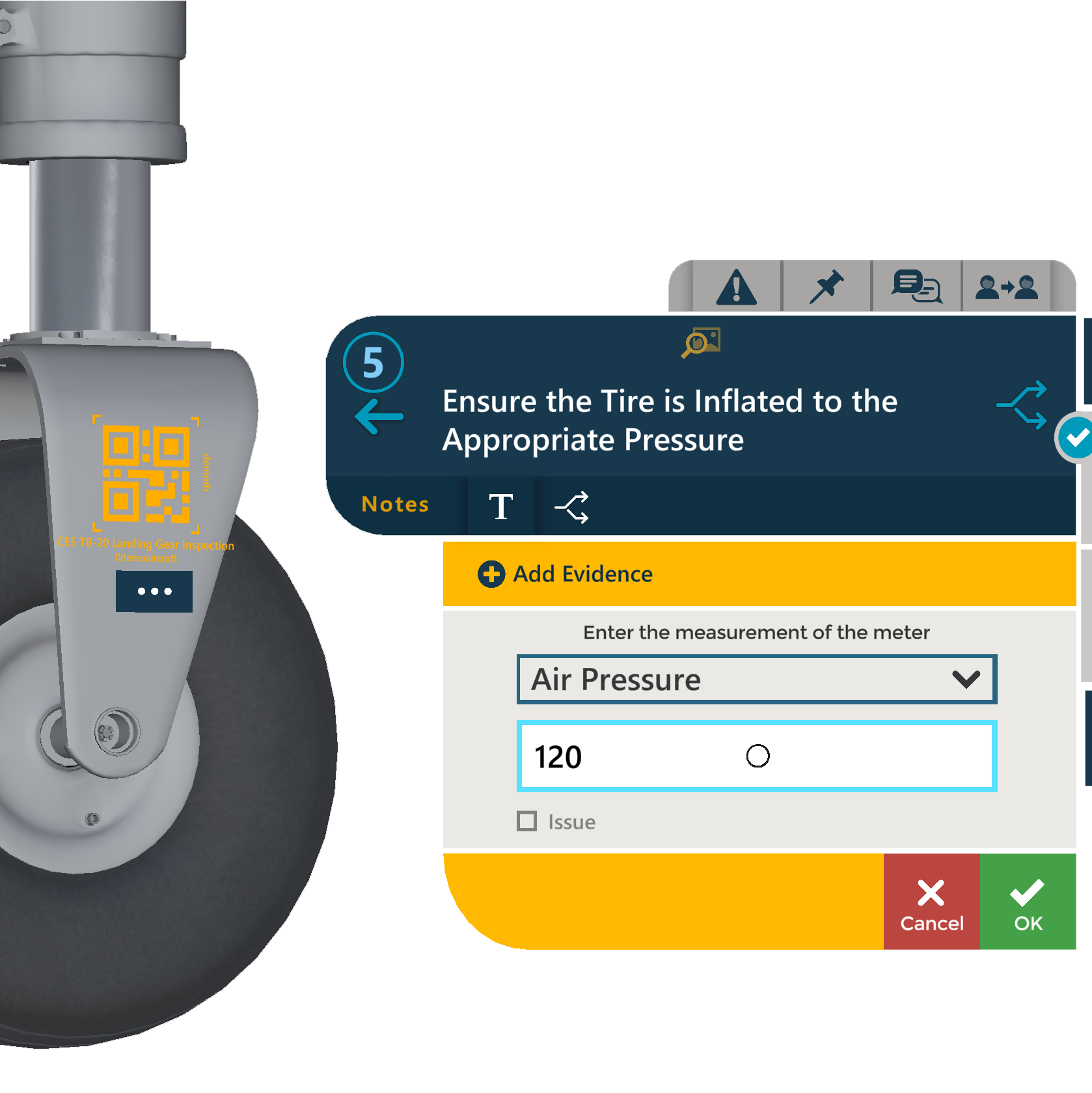
Custom Evidence
An Author may configure a Custom Evidence Note type for any Template. A Custom Evidence list is a preset value list from which an Operator may select to input an Evidence Note for that Job Step. This is ideal for procedures where a standardized set of data or status definition must be recorded on some or all Job Steps. Custom Evidence lists must be associated to any applicable Template. There is no limit to the number of Custom Evidence lists that can be associated
Sub-Jobs (Embedded Templates)
An Author may use an Embedded Template Note to link procedures together. A Job Step with a Template Note will generate a Sub-Job that the Operator must complete before completing that Job Step. Below are a few notes about Sub-Jobs:
- The Sub-Job will open a new Job checklist window from the parent Job and prompt the
- Operator to complete before returning to the originating Job Step
- If the Sub-Job links to a different Asset, the Operator will be prompted to scan the relevant Asset to continue
- Once the Operator has completed the Sub-Job, the Job checklist will close and automatically navigate the Operator back to the originating Job Step in the parent job to complete
- If there are multiple levels of nested Sub-Jobs, the Job checklist windows will continue to stack in front of each Parent Job
- *Note: Templates in Preview or Auto Preview mode will not go into Sub-Jobs or Choice Notes for a Template. Preview modes will only play through the Parent Template and show which Template is associated with the Template Note. To run through the complete flow as authored, it must be performed as a Job
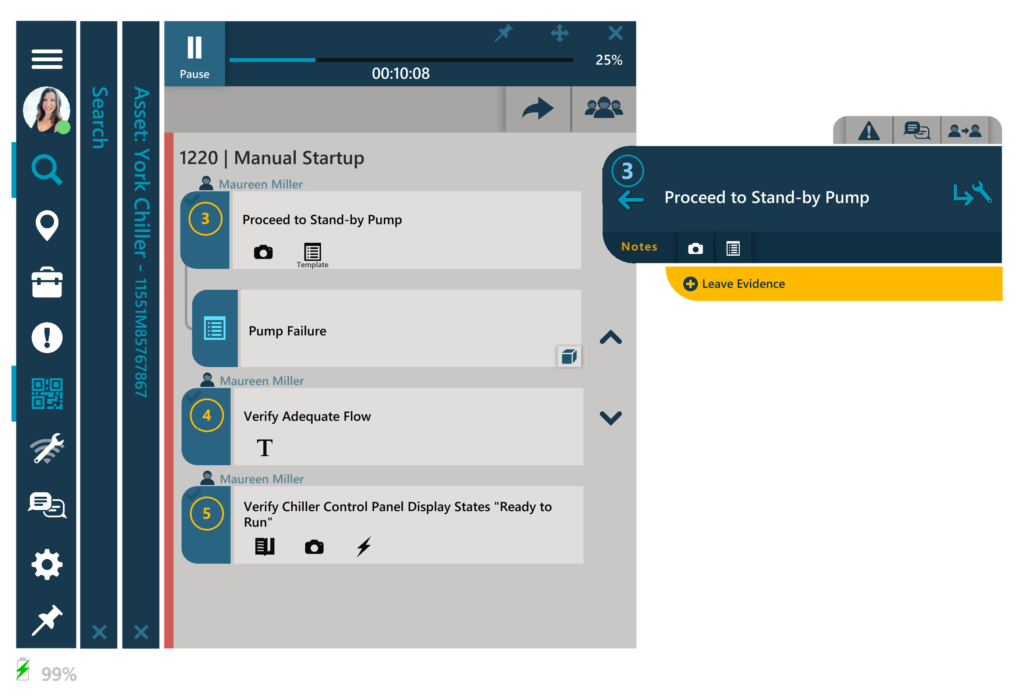
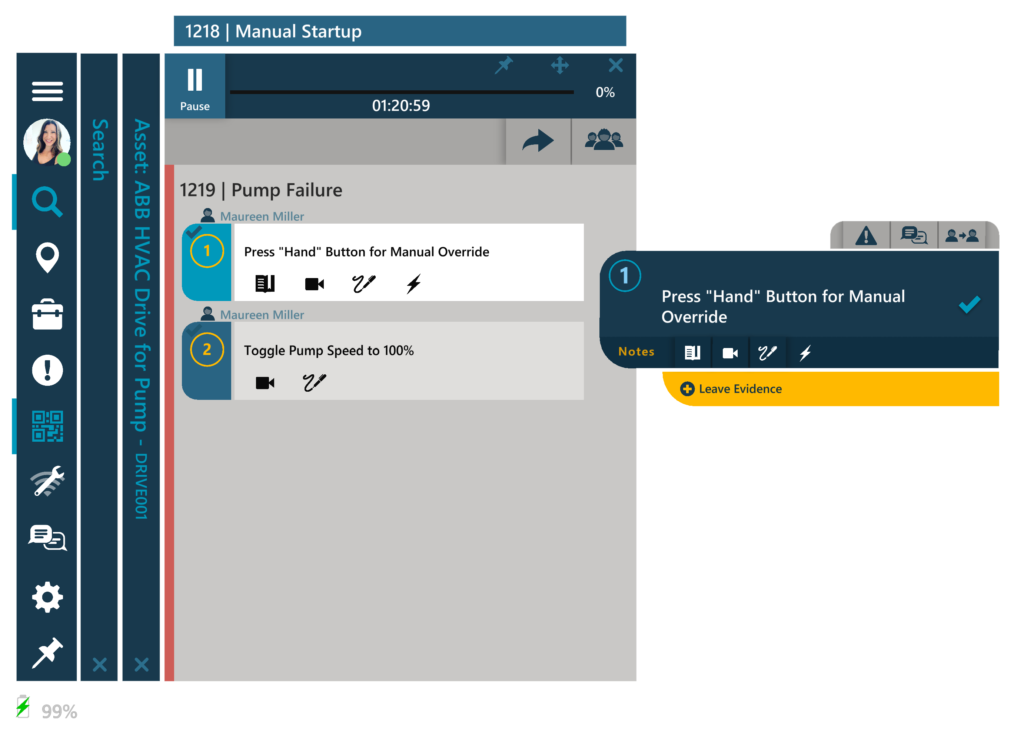
Choice Options
An Author may use a Choice Note to present the Operator with multiple options to select from when working on a Job Step. Choice Note options may link to other Templates, generating a Sub-Job; or simply log a specific selection before the Operator can continue and complete a Job Step. Below are a few notes about Choice Notes:
- A Step authored with a Choice Note may display up to 26 optional paths that an Operator can select from to continue
- Options may be authored to continue to the next Step or continue to a Sub-Job
- If the option directs the Operator to a Sub-Job, this Job will open in a new Job checklist and must be completed before the Operator can return to the parent Job checklist and originating Step
- Once the Operator has completed the Sub-Job, the Job checklist will close and navigate the Operator back to the parent Job checklist
- At this time, the Operator can either select Done or select another option if further paths are required
- An Operator may select the same option for a sub-job as many times as necessary before marking the step as complete
- The Choice Note options the Operator selects will be inserted below the Step on the Job checklist
- *Note: options associated with Sub-Jobs will be indicated
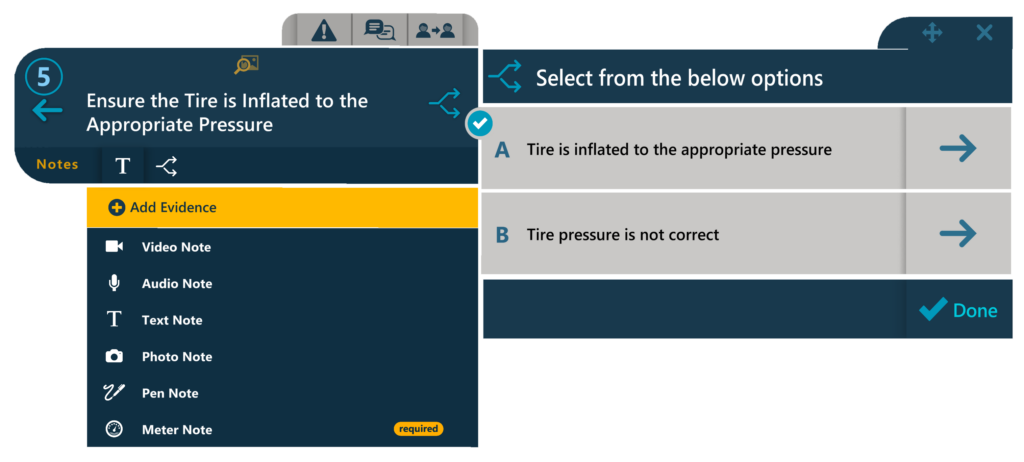
Job Faults
While performing a Job, an Operator can add a Fault on any Step to quickly indicate an issue. This feature is well suited for inspection procedures or any case where an Operator may need to indicate a Fault in a Template or on an Asset. When Faults are recorded, these will be flagged for the Location, Asset, Job, and Step, allowing viewers to quickly identify and resolve issues.
Add a Fault to a Step
While performing a Job, Operators can add a Fault on a Step by selecting the Add Fault button located on the top of the Step Marker. This will generate an AR Fault Marker which can be spatially positioned at the location of the Fault.
- From the Step Marker, select Add Fault

- Select, hold and drag the AR Fault Marker to place it near the location of the issue
- Enter a Fault Description (required)
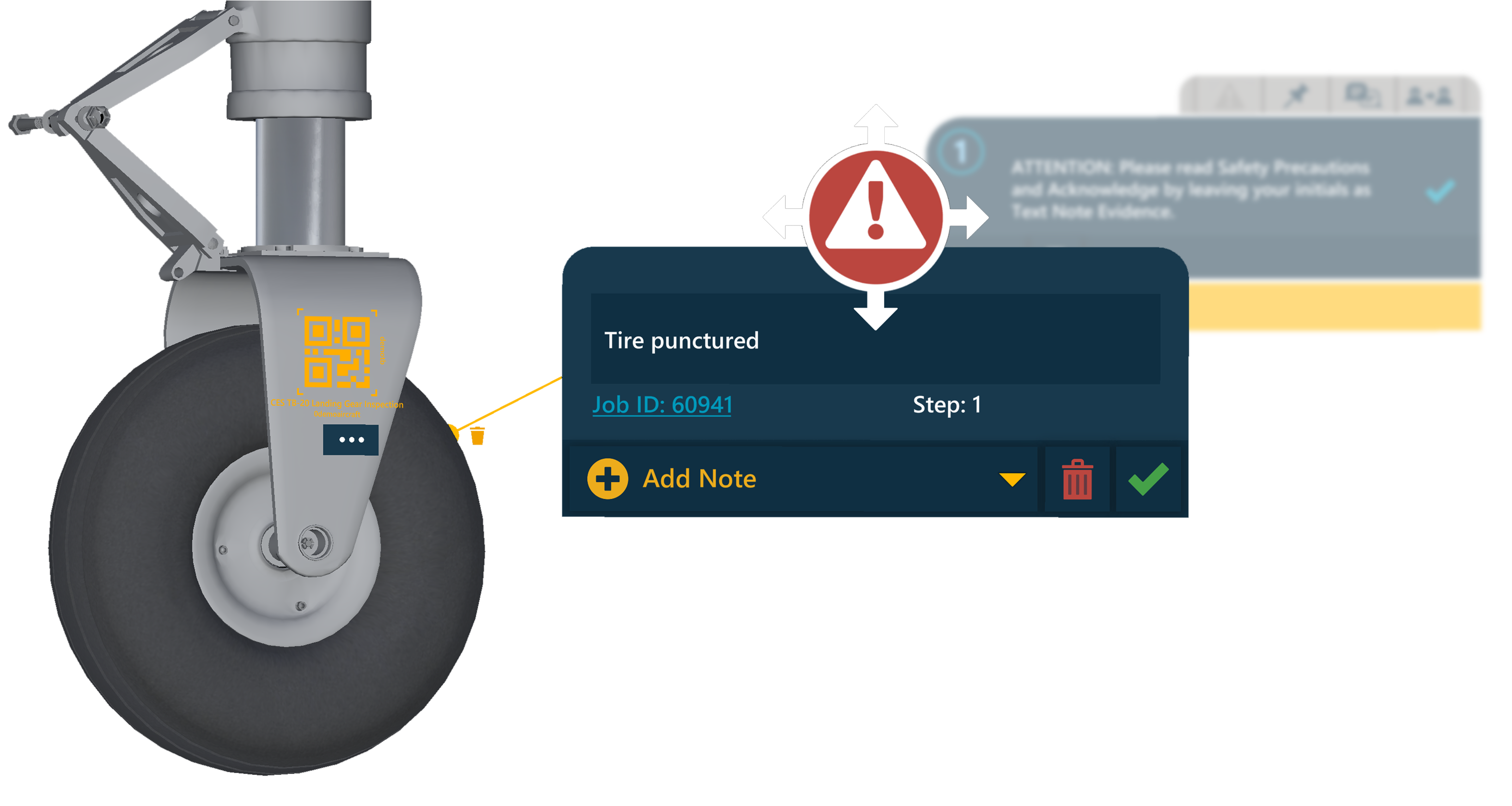
- Select Add Note to view a list of available Fault Note options (if a type of Fault Note is required, this will be denoted by a yellow ‘required’ icon)
- Once the required Fault Description and any relevant Fault Notes have been added, select the green checkmark to save the Fault
*Note: To discard the Fault during creation, select the red trash icon. Faults cannot be deleted once saved.
Review Mode
Job Review allows Manifest 3D users to access a completed Job and step through it. Users can navigate through all Steps highlighting any Evidence Notes and/or Job Faults that were logged by the Operator when completing the procedure. In Review Mode, the Steps will automatically play any Pen Notes the Operator may have logged during a Job Step.
Access a Job in Review Mode
- Search for the Asset OR scan the Asset Tag for the desired Asset and go to the Asset Detail window
- From the Asset Detail window, select Work History
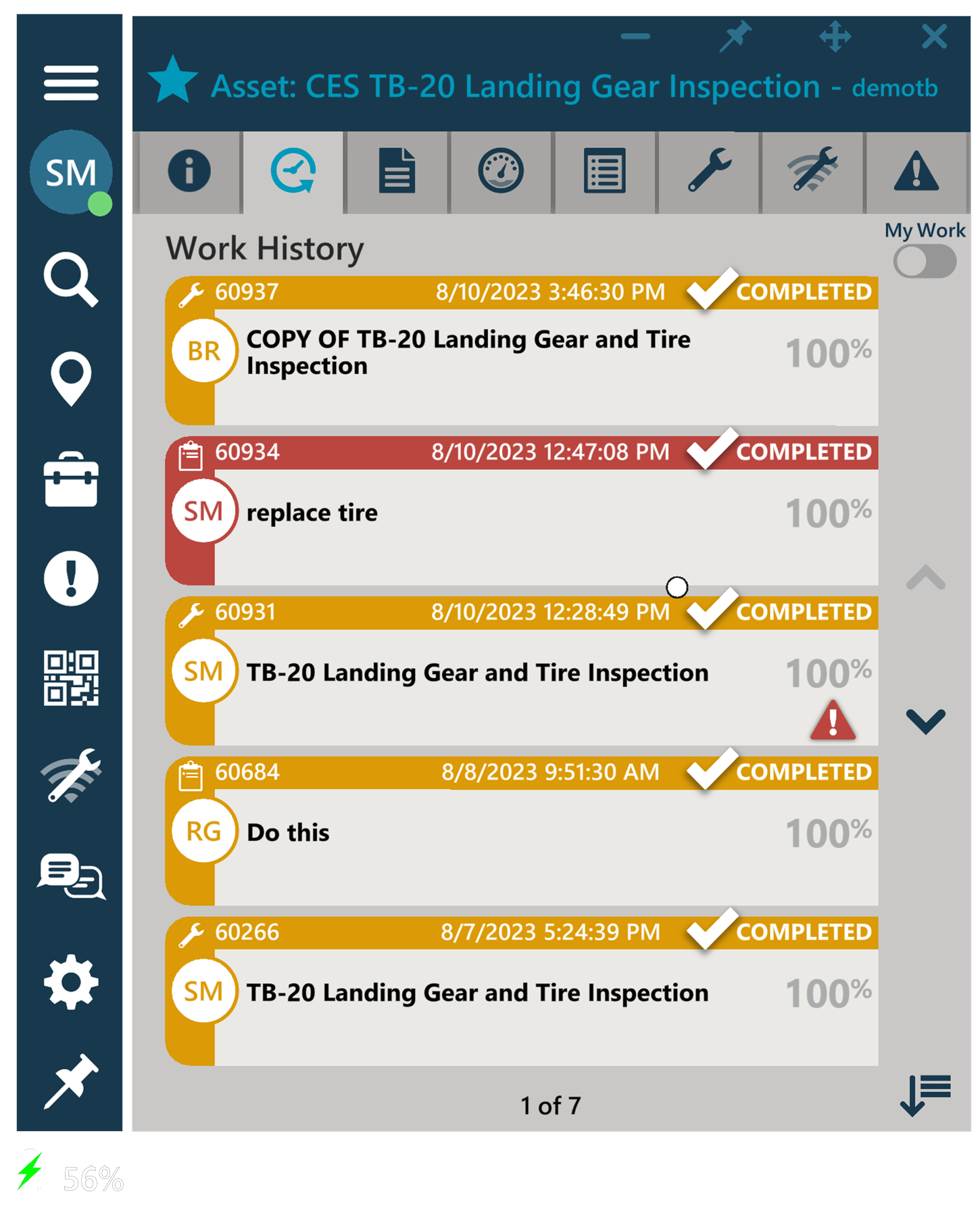
- Find the completed Job in the Work list and select it to open the completed Job checklist
- Navigate through the Steps, and review any Evidence left by the Operator using the controls at the far right-hand side of the screen
- The Job will render the spatially positioned Step Markers as authored in the Template, allowing the viewer to walk through the Job step-by-step as performed by the Operator
- If a viewer has filtered the Job to show Faults, Review Mode will only play through the Steps containing Faults
- Operators can view any Faults in Review mode by selecting the Show Fault button (this will open the Fault Marker and Fault Listing) to display the Fault Description, any available Notes, associated Work, and available Fault actions.
Alignment Action
With any procedure that spans over a large asset or area, spatially anchored content may lose accuracy the further it is from the scanned Asset Tag. Alignment Actions allow Authors to realign Steps to an Alignment Tag at any stage in a procedure. If a procedure has been authored with one or more Alignment Actions and the Operator is working in AR mode, the User will be prompted to scan an Alignment Tag when arriving to a Step with an associated Alignment Action. The app will render an arrow to point Operators in the direction of the next Step and Alignment Action.
- If a Job Step has an ‘Alignment Action’ associated, the Operator will be prompted to ‘Scan Alignment Tag’
- Locate the Alignment Tag for the Step (a QR code with the word “align” printed underneath)

- Select Scan Alignment Tag from the window prompt to initiate the scanner
- Scan Alignment Tag
- Confirm the scan is precise (if necessary, select Re-align Tag to scan that Alignment Tag again)
- Continue the Job
Job Assist
Manifest Connect allows Manifest users to connect with other users to seek assistance from an expert or to share a real-time view of Work in progress. Manifest Connect is accessed directly from the Job Step Marker.
- From the Step Marker’s top menu bar, select Connect
- A list of all licensed Manifest Operators and Authors for the domain will slide out from the Step Marker
- *Note: the contacts are shown in order of relevance beginning with the original Template Author, Operators who have recently performed the Job, and then all other licensed Manifest users for the domain
- Selecting the desired contact will enable the Call option
- Select Call
- The call window will open giving the Operator the option for live 1:1 audio. Both users can also share video
- Select Cancel to cancel the call
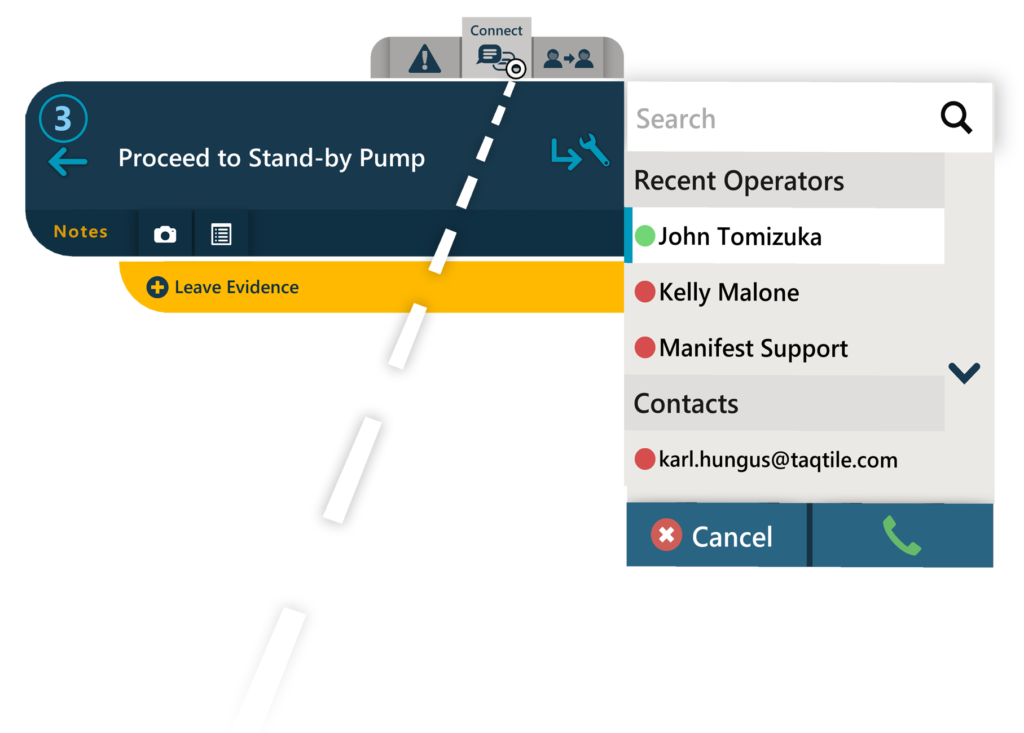
Team Jobs
Team Jobs allow multiple Operators to plan and collaborate on the same Job by dividing up the Step assignments among two or more Operators on a single Job.
Team Job setup
Once a job is created and assigned, Steps can be self-assigned by Team Members, or the Team Owner can assign Steps to other Team Members. Only the Team Owner can assign Steps to other Team Members and Lock or Unlock the Job. The Start Job button will be disabled until Step Assignments are complete and the Team Owner has locked the Job.
From Job view
- The Operator who initiates a Team Job will act as the Team owner
- To create a Team Job, the Team owner should first create a Job from the desired Template
- From the Job checklist window, and before the Job has been started, the Team owner selects Team setup in the upper right-hand corner of the Job checklist
- A Contact List will slide out with a list of all licensed Manifest Operators for the domain (and their online status)
- Select each Operator that should be invited to the Team Job and then select Invite
- Invites will be sent via Manifest Connect Chat to each invitee at which time they can select either Accept or Decline
- The Team Member list will dynamically update based on the acceptance status of each invitee (‘accepted’, ‘declined’, or ‘pending’)
- A Group Chat in Manifest Connect will be generated and Operators will automatically be added as they accept the Team Job invite
Team Job assignment
Once a Team Job is created, the Team owner can either assign Steps to each Team Member or they can self-assign the Steps to themselves.
- To assign Steps to other Team members, the Team owner should first select the Operator Username in the Team Contact List
- The Team owner must then select each Step they would like to assign to that Operator by hovering over each Step number to reveal the Assign option
- *Note: Only Team members who have accepted the invite can be assigned Steps
- Each Team Member can simultaneously self-assign themselves Steps by hovering over the Step number and selecting Assign
- The Step assignments will update in real-time for all Operators displaying each associated Username over their Step assignment
- When ready, the Team owner must complete the Team setup by selecting the Lock button from the bottom window bar
- This finalizes all Team members and their assignments and cannot be edited unless the Team owner unlocks the Job
- The Job cannot begin until the Team setup is complete
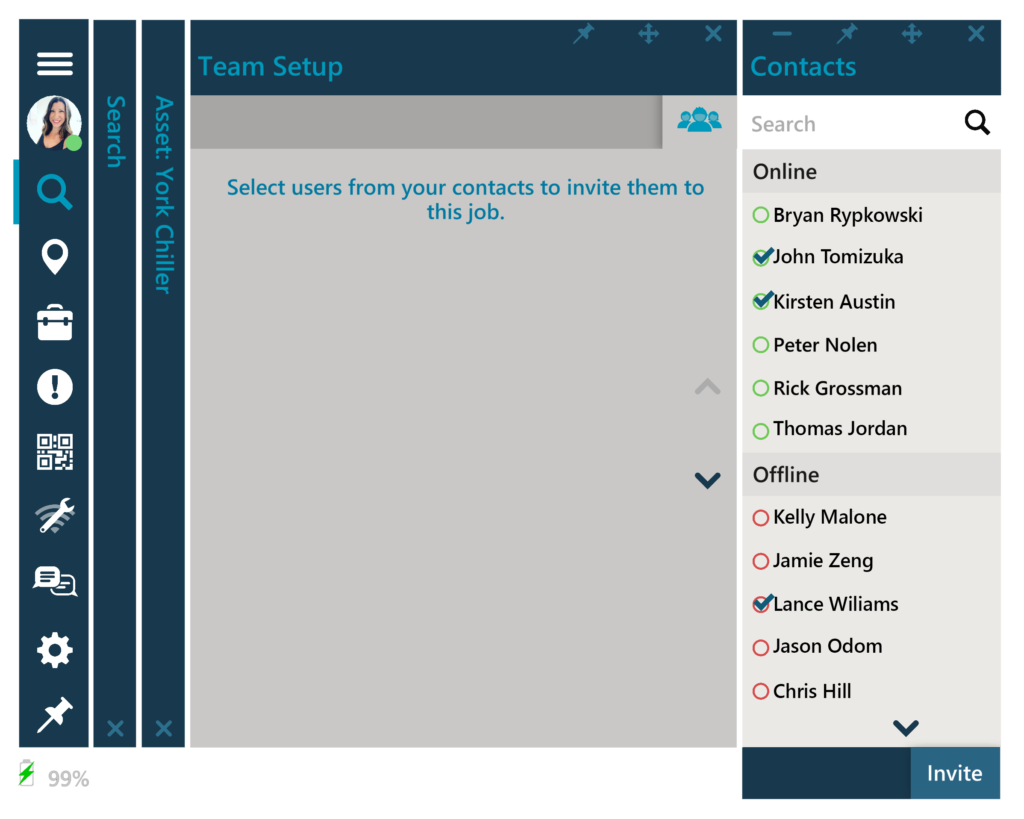
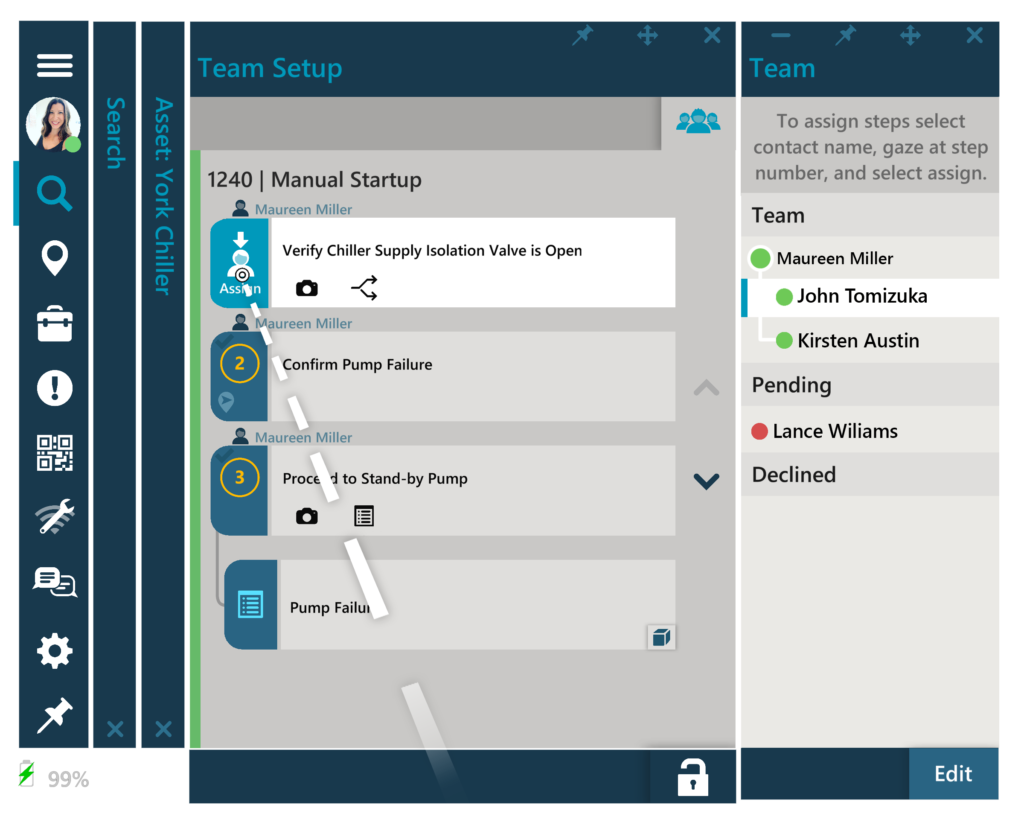
Performing a Team Job
- A Team Job can only be started by Operators assigned to the first Step in a Job
- The Start Job button will remain disabled for users not assigned to the first Step in a Team Job, as all steps must be completed chronologically
- The Job actions will only be enabled for the Operator assigned to the current Step, e.g. If Step 1 is assigned to Betsy Smith, Betsy is the only user who will be able to Start/Resume the Job or mark that Step Done
- Users will be notified via in-app notifications when it is their turn to perform a Job Step
- The Team Owner can Unlock the Team Job at any time, but this will automatically pause the Job and any Work currently in progress
- When a Job is Unlocked, Steps may be reassigned and updated until the Job is Locked again
- A Group Chat in Manifest Connect will be automatically generated and associated with the Job Title / ID for Team Members to communicate and collaborate throughout the procedure
- Once the last Job Step has been completed, the Job checklist will update to display the final logged Job time and completion date, the Group Chat will be archived, and that/those final Team Member(s) will receive the “Congratulations!” prompt
Additional Work tools
View in Job History
To view the service history on any Asset, visit the Work History and review any previously completed Jobs or Tasks performed on the Asset.
- Search for the Asset or scan the Asset Tag for the desired Asset and go to the Asset Detail window
- From the Asset Detail window, select Work History

- Find the Job or Task you wish to review and select to open into a new window
- From a completed Job checklist, you may review Faults or play the Job back in Review Mode which will load all 3D content, including Evidence Notes, and allow a user to step through the Job step-by-step as performed by the Operator
Preview a Job Template
Previewing a Job Template allows users to play through a Template in 3D Mode without generating or performing the Job. This is a useful tool enabling Authors to review their procedure, help Operators preview and prepare for a Work procedure, or provide reviewing capabilities to other Viewers such as trainees or managers. To preview a Job Template:
- Search for the Asset or scan the Asset Tag for the desired Asset and go to the Asset Detail window
- From the Asset Detail window, select Templates
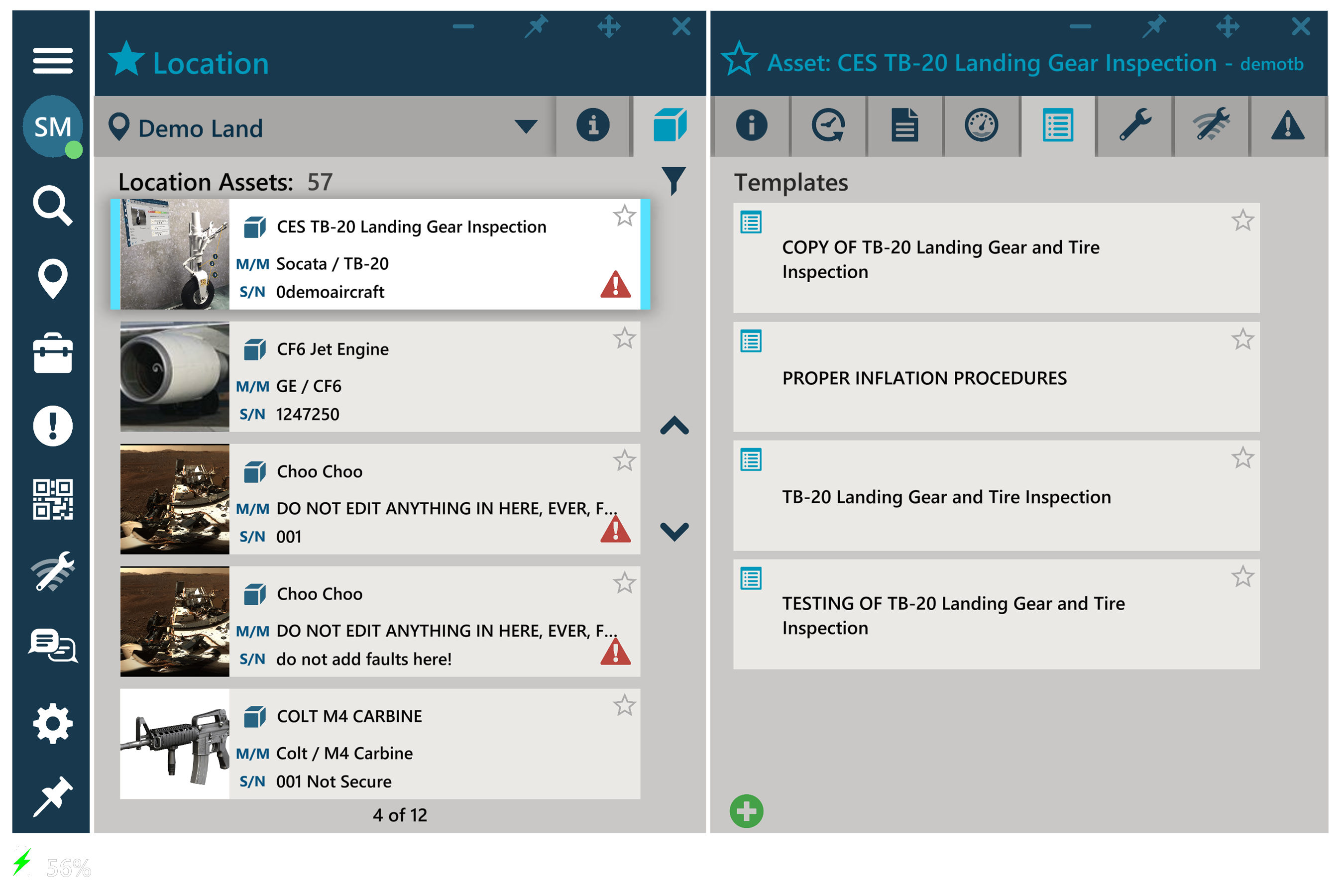
- Find the Job Template in the Template list and select it to open into a new window
- In the window menu, select either the option for Preview or Auto–Preview
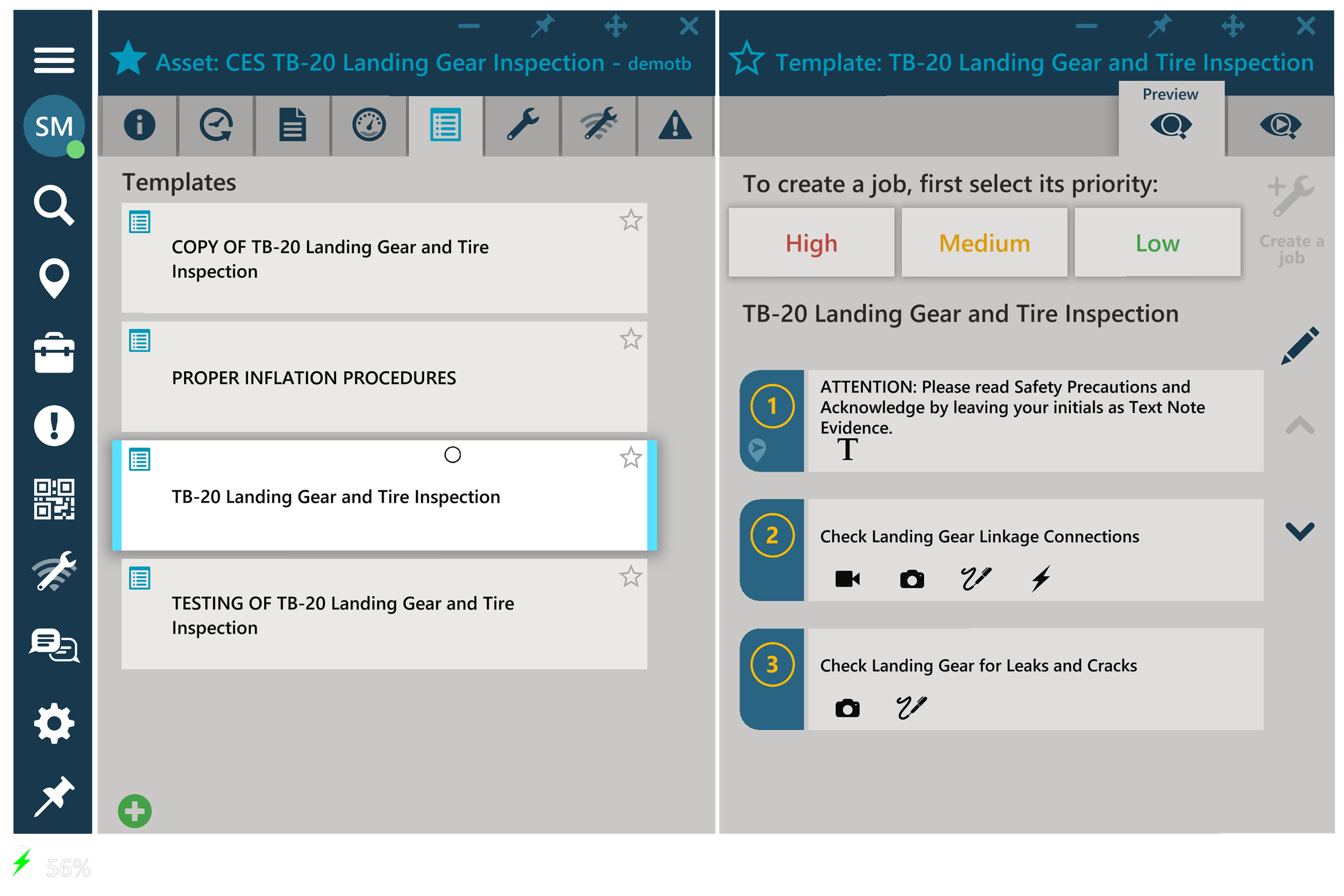
- Preview allows you to manually go through the Job Steps and load each Step Note Auto-Preview will automatically load all Step Notes and progress through each Job Step based on a timer so you can review hands-free. To stop or pause the auto-preview, simply select this option from the upper-right corner
- *Note: Templates in Preview or Auto Preview mode will not include Sub-Jobs or Choice Notes for Template. Preview modes will only play through the Parent Template and show that a Step which Template is associated to the Template Note. To run through the complete flow as authored, it must be performed as a Job
Offline Work
If the Job must be performed in an area with limited to no network connectivity, Manifest Offline capabilities enable Operators to save their Jobs into an Offline Work Package to be completed in a disconnected environment, and then synced with the server when connectivity is restored.
Taking Jobs offline
Jobs can be saved to an Offline Work Package only while online and with network connectivity, either from the Work window or the Work tab in the Asset Detail window.
Taking Jobs offline via the Dashboard My Work tab:
- Navigate to the Dashboard My Work tab
- Select the icon of the wrench and WiFi symbol
 in the upper right-hand corner to open Work Offline Setup
in the upper right-hand corner to open Work Offline Setup 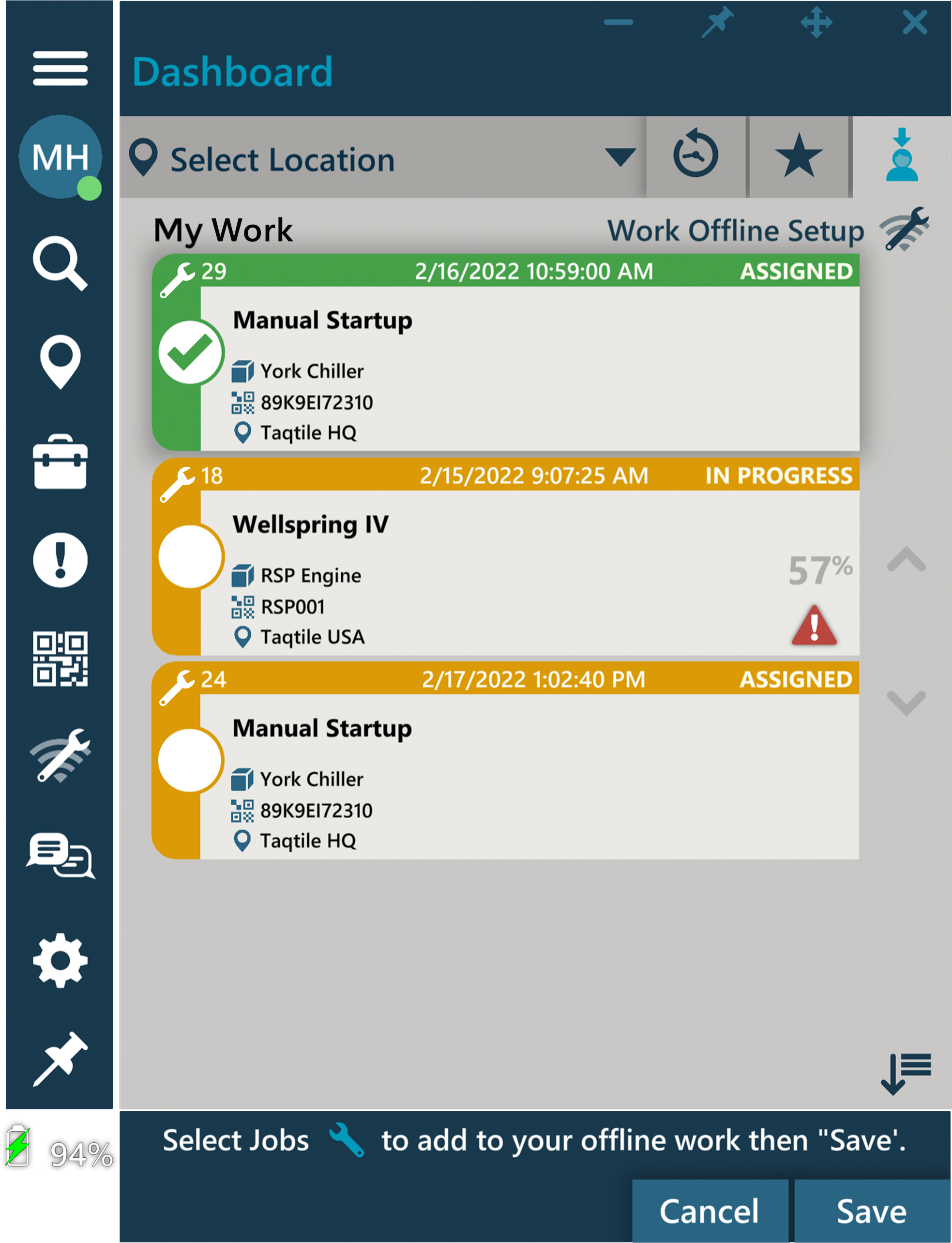
- The Job Listing Avatar will become a selectable circle and a bar with options to save to the Offline Work Package (or cancel) will expand from the bottom of the window
- Tap the white circles of each Job Listing to select the Jobs to be taken offline
- Select Save
- If this is the first-time taking Work offline a 6-digit security PIN will be required to be configured and Operators will be prompted to do so
- The window will display a progress animation as the Jobs are saved to the Offline Work Package
- Once complete, the My Work tab will return to view. Any Jobs saved to the Offline Work Package will display the Offline wrench and WiFi icon in the lower left-hand corner to indicate the Job is saved Offline.
Taking Jobs offline via the Asset Window:
Jobs can only be saved to an Offline Work Package while the AR headset still has network connectivity.
*Note: Team Jobs cannot be taken offline.
- Search for the Asset or Scan the Asset Tag for the desired Asset and go to the Asset Detail window
- From the Asset Detail window, select Work Offline
- Filter by Jobs.
- *Note: Only those Jobs assigned to the Operator will be shown
- Select the Jobs that are required to be performed offline
- Once the items are selected, a Save or Cancel option will expand from the window . Select Save
- If this is the first-time taking Work offline, a 6-digit security PIN will be required to be configured and Operators will be prompted to do so
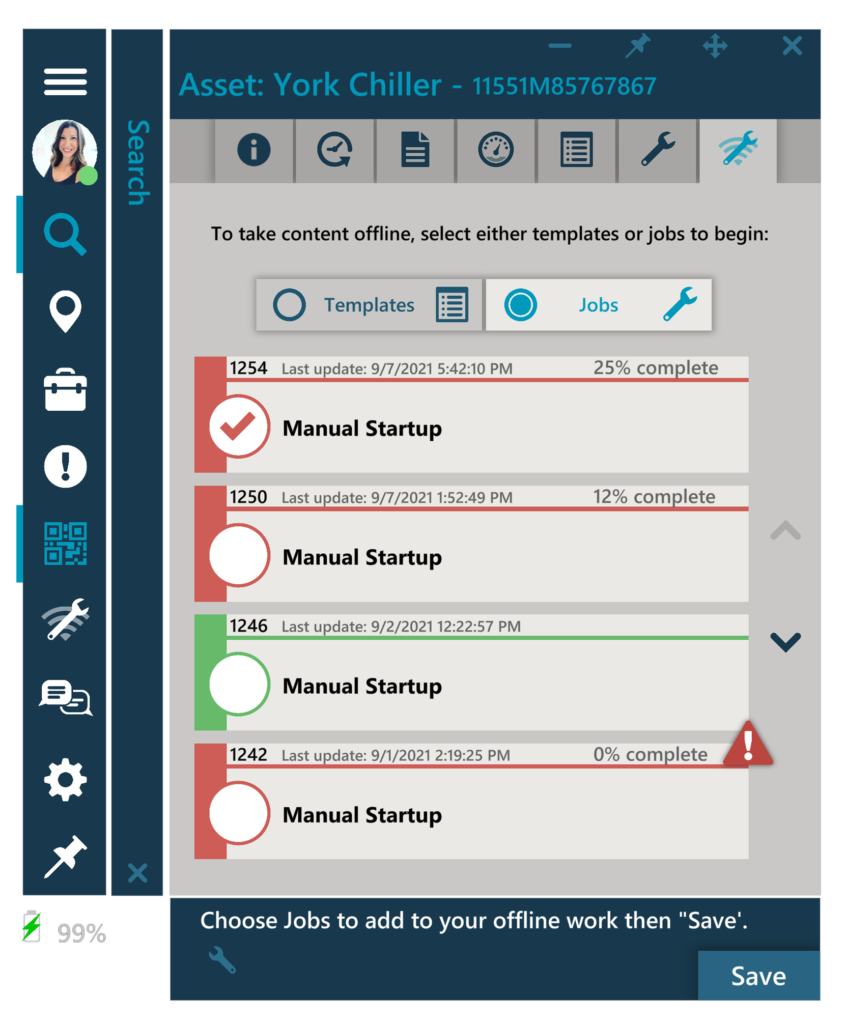
Working offline
- Once your Offline Work Package is successfully saved, Operators may logout and leave WiFi range
- From the Login window, Operators select Work Offline and enter their email and 6-digit security PIN
- Search for the Asset OR scan the Asset Tag for the desired Asset
- Select Start or Resume as normal
- Complete the Job
- Once connectivity is restored, all data generated during Offline Work will be synchronized to the server and the Job will be removed from the Offline Work Package
- To resume an In Progress Job offline again later, the Operator must resync the Job to their Offline Work Package
- If the connection is not strong enough to successfully synchronize the offline data, Manifest will reattempt to synchronize after future logins
